For the best Oliver Wyman website experience, please upgrade your browser to IE9 or later

- Global (English)
- India (English)
- Middle East (English)
- South Africa (English)
- Brazil (Português)
- China (中文版)
- Japan (日本語)
- Southeast Asia (English)
- Belgium (English)
- France (Français)
- Germany (Deutsch)
- Italy (Italiano)
- Netherlands (English)
- Nordics (English)
- Portugal (Português)
- Spain (Español)
- Switzerland (Deutsch)
- UK And Ireland (English)
B2B telecommunication companies (telcos) find themselves in a transformative landscape of technology orchestration and platform evolution — leading to the potential for redefining their business models. Our in-depth report, “The Future Of B2B Telco”, navigates the intricate journey of telcos transitioning into tech orchestrators, seamlessly integrating connectivity, cloud solutions, cybersecurity, data, and applications.
In an era marked by the commoditization of traditional connectivity , telcos face a pivotal crossroads. The decline of fixed voice, not offset by data connectivity, coupled with the ascendancy of hyperscalers and digital/tech players, propels telcos toward a rapid business model shift. The challenge lies in avoiding strategic deadlocks and articulating a precise strategy to maintain their unique position in the market.

The rise of tech services in B2B Telcos
The commoditization of traditional telecom connectivity is rapidly increasing, resulting in a decline in fixed voice revenue ranging from 8% to 15% annually, depending on the location. This decline is not being offset by the growth in data and mobile connectivity revenues, which are only growing by 1% to 3% per year. However, there is good news in the form of the thriving tech services market, which is growing at a rate of approximately 10.5% per year.
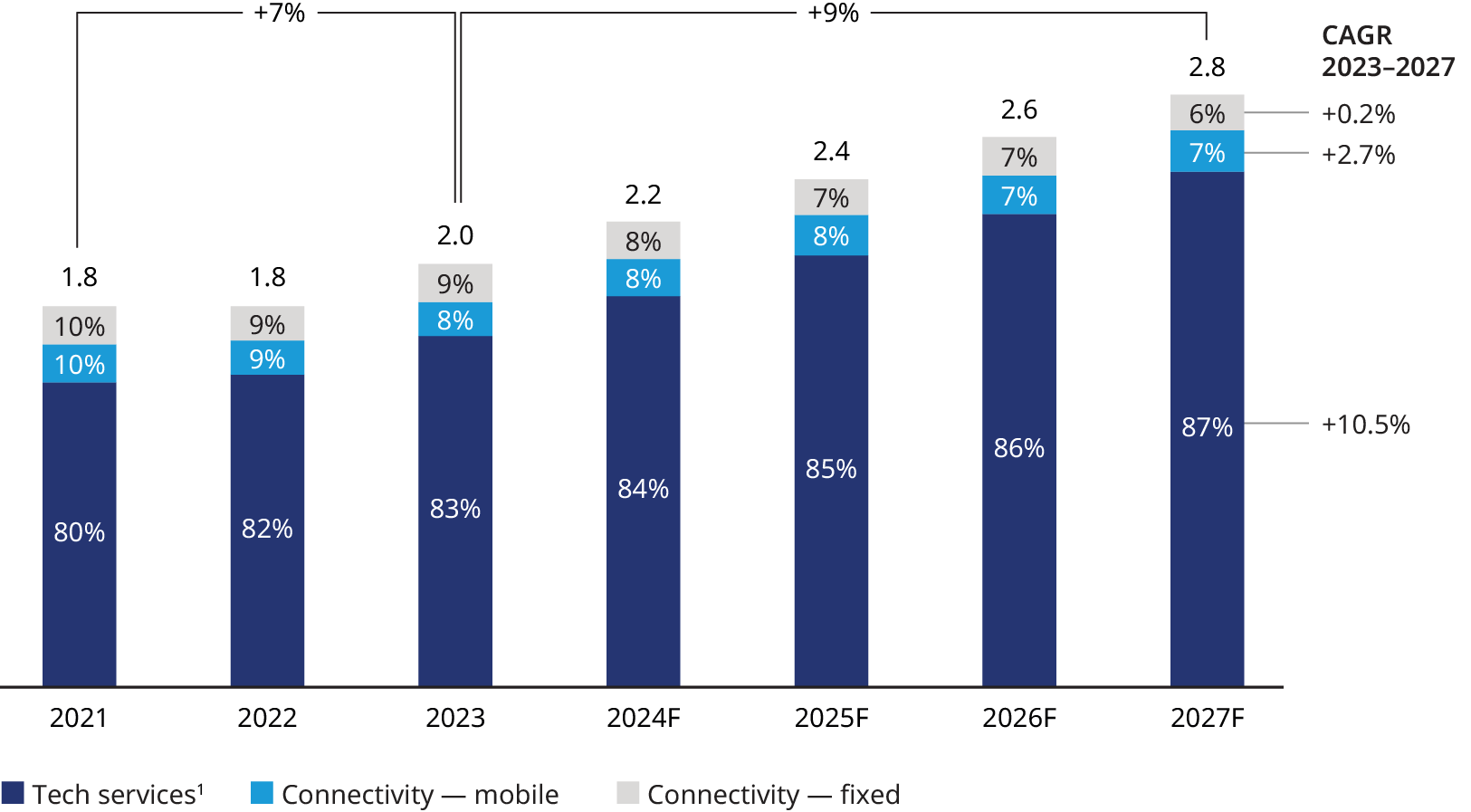
In 2021, tech services accounted for 80% of the B2B technology and connectivity market, and over the past three years, their market share has increased by 3 percentage points to reach 83%. It is expected that by 2027, tech services will gain an additional 4 percentage points, reaching an 87% market share. This promising market opportunity has prompted most telco B2B organizations to focus on and expand their tech services business in recent years.
However, the mix of tech services varies greatly among operators at different stages of their B2B journey. Some operators have already surpassed the 50% mark, while others are at or below 25%. The challenge for operators is not only to capture part of this growth but also to manage the transition from a high margin, low growth business to a low margin, high growth business.
Strategic focus areas shaping the integration landscape
Our report guides you through five pivotal technology areas shaping the integration landscape. Telcos, leveraging their distinctive strengths, emerge as pioneers in these critical technological frontiers:
- Cybersecurity: Telcos carve a niche with network security, identity and access management , endpoint security, zero trust, and security operation centers (SOC). The cybersecurity market share of telcos indicates untapped potential for growth.
- Cloud solutions: Telcos play a crucial role in private cloud services, reshaping connectivity architecture, and providing cloud orchestration and managed services.
- Data organization: Leveraging their access to abundant data, telcos secure critical infrastructure, pioneer sovereign cloud solutions, and delve into identity management.
- Edge computing: A natural fit for telcos, though a long-term bet, offering services for real-time processing in applications like industrial automation and smart cities.
- Internet of things (IoT) solutions: Despite being in its infancy, telcos assert a clear right to win in IoT solutions, focusing on selected vertical bets and navigating the convergence of IT and engineering.
Key trends and strategies crucial for the future success of B2B telecos
The importance of seamless integration.
The report delves into the industrial applications race where telcos, IT services players, and hyperscalers vie for a position, but there is room for partnerships. The capability to orchestrate solutions by seamlessly integrating networks, cloud, data, applications, and security becomes paramount for the digitalization of the economy.
Shifting the paradigm to become platforms
As telcos evolve into platforms and industrial integrators, a radical portfolio simplification becomes imperative. Complexity gives way to strategic focus, amplifying agility and refining the organizational core. We explore inspiring examples of players cutting their portfolio while improving business agility and commercials.
Revolutionizing the go-to-market
The report further explores how telcos should embrace a paradigm shift from telco-first to tech-first in the go-to-market model. Seamless synchronization between sales and delivery, consultative selling, stronger margin visibility, new pricing models, and reimagined strategic partnerships are critical dimensions. This evolution ensures a cohesive approach between sales and delivery, a deep understanding of client needs, economic discipline in pricing, and dynamic collaborations. Simultaneously, a customer-centric focus unfolds, emphasizing an enterprise-first strategy while addressing the unique challenges and opportunities within the SME segment. This strategic realignment not only reshapes service delivery but also ensures a tailored and responsive approach to diverse client needs.
The skills challenge in telcos
The workforce challenge looms large as telcos adapt to new capabilities required for IT services. In our report, we look at the actions needed to lay the foundations for the future workforce requirements in telco B2B.
Integrating global innovation and local precision
In the dynamic B2B telco landscape, the challenge lies in seamlessly integrating global innovation with local precision. Current organizational models face inefficiencies, restricting operating margins, agility, and customer experiences. To counter this, operators must adopt a transformative approach, establishing a unified global product function while maintaining local delivery and pre-sales focus. Shifting to a customer-centric model, simplification of structures, and strategic near and offshore initiatives become imperative, positioning B2B Telco for success in an evolving tech-centric future.
Unlocking value through tech unit carve-outs
Examining the triumphs of pioneers, the benefits of investing in and adapting organizational structures for non-connectivity pursuits in B2B telco are evident. Over the past five years, a trend of tech unit carve-outs has surged, often driven by shareholder pressure for value optimization. Initial assessments, comparing telco EV/REV multiples to pure-tech companies, suggest promising returns. However, unlocking value through a carve-out demands strategic rationales, granting the new unit autonomy in management, investments, channels, geography, and partnerships.
The process, while promising, poses challenges. Additionally, carving-out high-growth tech units raises concerns about the future of the remaining connectivity segment. Assessing whether the benefits outweigh the risks is operator and market-dependent, necessitating careful evaluation by management and investors. Solely financial motives for carve-outs may not justify the complexities, risking the re-allocation of value within the group rather than unleashing its full potential.

- Communications, Media, and Technology
- Emmanuel Amiot and
- Christian Spielberg
Strategies Redefining Success In The Media Industry
Uncover the strategies used by top-tier media entities to leverage technology and unique value propositions to navigate media industry disruption.
Navigating Churn In A European Telecom Operators Landscape
Discover the complex landscape of customer retention in the European telecommunications sector as we analyze the factors that challenge operators worldwide.
What separates B2B GTM outperformers in tech and telecom
Long before the pandemic spurred an unprecedented wave of enterprise digital transformation, B2B customers sought the ability to buy through various channels, just as they already enjoyed as consumers. It’s only natural that B2B buyers in tech and telecom, in particular, have come to expect their suppliers to deliver on that promise, given the sector’s leading role in driving the seismic shifts of recent years. These decision makers are embracing companies that provide a seamless and personalized omnichannel experience and increasingly turning their backs on those that don’t.
About the authors
This article is a collaborative effort by Dianne Esber , Luca Furlani, Jacklyn Nagle, Naveed Niwaz , and Karolina Sauer-Sidor , representing views from McKinsey’s Technology, Media & Telecommunications Practice, McKinsey’s Growth, Marketing & Sales Practice, and our NeXT Commerce Initiative.
Three years have passed since this new “omnichannel” era was ushered in, and B2B providers in tech and telecom are ahead of the curve in satisfying the heightened expectations of their buyers. A sizable majority feel that this modernization effort is paying dividends—73 percent of tech and telecom companies agree that their sales model is more effective at reaching and serving customers overall compared to a year ago, and 76 percent believe that it is more effective at acquiring new customers (versus 68 and 71 percent, respectively, for overall B2B companies). Furthermore, the approach appears to resonate with their customers; 65 percent of tech and telecom companies say that their customers have given positive feedback on the number of channels they have (versus 60 percent overall). Lastly, the results show it’s working; tech and telecom B2B companies that provide the best omnichannel experience are seeing their market share jump by at least 10 percent annually, while those that fail to do so are losing share on a regular basis.
About our research
We began conducting our cross-sector B2B Pulse survey annually in 2016, and the trend toward an omnichannel environment was quickly evident. The most recent B2B Pulse GTM tech and telecom survey was conducted in December 2022, gathering responses from more than 750 B2B customers and sellers in decision-making roles in Australia, Brazil, Chile, China, France, Germany, India, Italy, Japan, South Korea, Spain, the United Kingdom, and the United States. Respondents provided details of their specific roles size in terms of employees and revenue, location, and market share performance. Questions focused on types of technologies and the extent to which they had been adopted, providing longitudinal data compared with previous surveys.
These are just some of the findings from this year’s global B2B tech and telecom go-to-market (GTM) pulse survey of approximately 750 decision makers across 13 countries, a subset of McKinsey’s annual broader B2B Pulse survey , which uncovered similar trends across sectors (for more details, see sidebar, “About our research”).
Despite those encouraging signs, tech and telecom B2B providers should beware—buyers can tell the difference between a provider fully committed to this sophisticated model and those just going through the motions. Our research found that to succeed, B2B sellers in tech and telecom must be fully invested in omnichannel and personalization, regardless of how uncertain the current macroeconomic climate may be. Furthermore, tech and telecom companies’ accelerated adoption of new sales tactics and integrated omnichannel motions is accompanied by growing pains that need to be managed in the coming years; for example, 43 percent of their customers are confused by channel conflict during the sales process, compared to 38 percent across industries.
This means that a holistic, multifaceted approach to modernizing B2B selling is no longer optional. Mastering just one or two modern sales and marketing tactics will help, but it won’t pay the full rewards that the outperforming tech and telecom B2B companies realize by simultaneously employing five major modern sales and marketing tactics: deploying advanced sales technology, delivering hyper-personalization, increasing hybrid sales teams and capabilities, growing their presence and tailoring strategies on third-party and their own marketplaces, and achieving e-commerce excellence across the full marketing and sales funnel. Companies that become proficient at all these methods reap the benefits of a multiplier effect—they are twice as likely to enjoy more than 10 percent market share growth than companies that only optimize one (Exhibit 1). While tech and telecom B2B winners are outpacing other sectors across all five tactics, the bar within the tech and telecom sectors has been raised significantly. To succeed, companies will have to continue to evolve and improve these more sophisticated techniques.
Key survey insights
Companies have long resisted calls for a seamless B2B buying experience similar to that of the B2C world by pointing out obstacles such as complexity, technical requirements, deal sizes, and the number of decision makers. Those arguments no longer hold water, and as our survey found, a personalized, omnichannel experience on par with B2C is now table stakes for B2B players to succeed.
We also identified several other clear trends:
- The “rule of thirds” holds. Even with the growing appeal of alternative channels, B2B customers in tech and telecom and across sectors haven’t turned away from traditional sales interactions. In fact, despite the temporary move away from in-person encounters during the height of COVID-19, they still generally prefer an evenly divided mix of traditional, remote, and self-service channels, such as in-person sales reps, inside sales, and e-commerce, respectively (Exhibit 2).
- By a wide margin, e-commerce is now considered the most effective sales channel in tech and telecom. Fully 42 percent of tech and telecom respondents view it as the best option, ahead of in-person sales (19 percent), video conference (15 percent), email (8 percent), online chat (8 percent), and telephone (7 percent). By contrast, our cross-sector survey found a smaller gap between the top digital and traditional channels, with 35 percent choosing e-commerce and 26 percent citing in-person deals. Many tech and telecom buyers also view online commerce as a more appealing option than offline across five key buying criteria: product availability (45 percent), pricing (44 percent), shipping and delivery options (45 percent), “on call” customer support (45 percent), and personalized recommendations (43 percent). And while tech and telecom companies across regions ranked e-commerce as the most effective channel, the strength of that conviction varies geographically: the United States leads the way with 47 percent of tech and telecom companies holding that view, followed by Asia at 38 percent and Europe at 36 percent. Finally, for outperforming tech and telecom companies, e-commerce means more than digital self-serve channels such as their own websites. Around half of them have already built an online marketplace, compared with just 15 percent of companies losing share.
- Customers are getting more comfortable with large e-commerce transactions. Until recently, the potential for channel conflict has been the biggest obstacle to more B2B players investing seriously in e-commerce: 44 percent of tech and telecom respondents said it was the “single biggest reason” that they have not considered selling online (versus 38 percent across sectors). But the sales growth opportunity may now be too valuable to ignore. Similar to last year, 67 percent of decision makers are prepared to spend more than $50,000 on a single e-commerce transaction in B2B (compared to 61 percent for all sectors), with the share prepared to spend more than $500,000 at 32 percent (versus 29 percent across sectors). This opportunity differs quite a bit by region, with the United States and China leading the pack (39 percent and 69 percent of buyers in the respective countries are willing to spend more than $500,000), while Europe lags at 22 percent.
- Capturing this opportunity in e-commerce requires a significant commitment to funding and new tactics. Despite the uncertain macroeconomic environment and overall tighter corporate spending, 70 percent of tech and telecom companies have increased their budget for e-commerce activities in the past year, with about a third seeing an increase of 4 to 10 percent and another quarter experiencing a jump of 11 to 25 percent. Furthermore, tech and telecom companies have adopted many e-commerce-centric tactics to optimize their online operation, such as introducing an online-exclusive product or service, optimizing promotional pricing, and introducing value-added services (24 percent, 21 percent, and 20 percent adoption, respectively).
- Tech and telecom companies are leading the charge in hybrid sales teams. Few sectors have as eagerly embraced the hybrid sales model as tech and telecom, where almost three-quarters (71 percent) of market share winners have deployed the mix of in-person and remote roles, compared with 57 percent for all industries. As for market share losers, just 38 percent of those tech and telecom underperformers are turning to the hybrid sales approach, about the same as their cross-sector peers. Large enterprises aren’t the only beneficiaries of the dynamic model; small to midsize companies with higher hybrid adoption rates also experience more significant share gains.
- Hyper-personalization is a critical differentiator. The most successful B2B companies know that they can no longer rely on standard, account-based marketing to communicate with customers. To gain market share, they use advanced technology and analytics-driven insights to target decision makers with customized messages and offers, factoring in their specific needs, profiles, behaviors, and interactions (both past and predictive). Twice as many tech and telecom winners (63 percent) as laggards (32 percent) have adopted such highly personalized marketing.
These trends suggest that the pandemic-driven shifts in channel usage were not a temporary blip but rather the start of a long-term, fundamental realignment. This raises several important questions for tech and telecom B2B companies, most notably: How are a select group of market share winners staying ahead of the pack? And what does it take to keep up with them?
What outperformers do differently
With the current global macroeconomic uncertainties, it is natural for many companies to have concerns about making additional investments in their sales organizations. However, the most successful B2B companies understand that such a moment of uncertainty can be the ideal opportunity to continue to expand their commercial resources and improve their omnichannel experience. Seventy percent of B2B outperformers (those reporting at least a 10 percent market share gain) had intended to increase their investments in sales organizations this year, while only 28 percent of share laggards had similarly bullish plans. Rather than simply plowing more of what they put into these critical roles, the outperformers are thinking differently and more holistically about how they evolve these roles and sell across the ecosystem of channels (and across the entire marketing and sales funnel).
In particular, B2B winners in tech and telecom focus on five crucial actions.
1. Adopt advanced sales tools
For a B2B company, constantly innovating and employing new sales technologies and analytics capabilities is essential for outperformance. Three-quarters of tech and telecom market share winners have already adopted advanced sales tools, 60 percent more than laggards. These tech and telecom winners are also 9 percent more likely than peers in other sectors to have adopted the tools, demonstrating the higher bar that tech and telecom companies have needed to reach to succeed.
Looking forward, tech and telecom companies cannot afford to rest on their laurels, as 36 percent of companies are planning to continue to invest in advanced sales tools and adopt the next generation of cutting-edge sales technology, such as automatic call logging with next-best actions, tools that prevent customer churn, or automation chatbots. These plans lag other sectors, where 45 percent are planning on investing, but that difference primarily reflects how much other industries have to invest in playing catch-up.
2. Shift account-based marketing to hyper-personalization
Taking a page from their B2C counterparts, the most successful B2B companies across industries increasingly use analytics and other sophisticated tools to communicate with customers in a highly personalized way. Tech and telecom companies remain ahead of the pack in adopting these sophisticated marketing tactics that leverage hyper-personalized targeting and content (15 percent more likely than all B2B companies). However, there is a considerable variation in the adoption within the sector; tech and telecom market share winners are twice as likely as laggards to implement this tactic (62 percent versus 31 percent).
This success in moving to hyper-personalization has not happened by accident. Tech and telecom companies have accelerated their ability to adopt and execute these tactics by investing in the tools and capabilities required to scale them effectively. Forty-four percent of tech and telecom companies have already invested in advanced technology that helps enable personalization, such as AI/ML, smart workflows, robotic process automation, and others (compared to 40 percent across industries). This investment is fast becoming a necessary ingredient for success, with 63 percent of tech and telecom winners investing here (double the share of laggards). Furthermore, 48 percent of tech and telecom companies have invested in new capabilities to help drive and execute personalization actions (compared to 42 percent across industries).
3. Roll out hybrid sales teams and capabilities
Of all the advanced sales tactics that B2B winners use, hybrid sales teams is where tech and telecom has a clear lead over most other sectors. Omnichannel sales models that combine human and digital channels have become table stakes in tech and telecom, with 55 percent of all companies in the sector already embracing this approach to some extent, compared to 47 percent on average for all other industries. The gap is even wider when it comes to B2B outperformers; 71 percent of tech and telecom winners have leveraged hybrid sales (with laggards at 29 percent) versus 57 percent for cross-sector winners (with laggards at 43 percent) (Exhibit 3). This approach is likely to become more common; 69 percent of tech and telecom companies expect the size of hybrid teams to grow in the next six months.
4. Leverage third-party marketplaces
Third-party B2B marketplaces are another sales tool that tech and telecom has utilized more extensively than other industries. Nearly half of all companies in tech and telecom highlight that they develop distinct strategies for each marketplace to maximize their strengths and weaknesses. Among the biggest tech and telecom market share winners, this increases to 64 percent versus 45 percent of share laggards (Exhibit 4). By contrast, 51 percent of outperformers across all sectors use similar third-party marketplace tactics, compared with 24 percent of laggards.
Among third-party marketplaces, tech and telecom has a slightly higher adoption of the two major players—Amazon and eBay—compared to all B2B providers (90 percent and 50 percent, respectively, versus 88 percent and 47 percent); on Amazon, in particular, a greater share of tech and telecom companies have used winning tactics such as developing a unique pricing strategy or targeting customers and markets not served by other sales channels. Furthermore, tech and telecom also leads in adopting industry-specific marketplaces, with 41 percent adoption (compared to 38 percent across all industries). On the other hand, while Alibaba and other regional marketplaces are popular with tech and telecom companies (34 and 21 percent), these adoption rates lag other sectors (39 and 23 percent, respectively).
5. Invest in company-owned marketplace
Just as they are making more use of third-party marketplaces, tech and telecom B2B companies are increasingly launching their own marketplaces as another sales channel. Adoption of company-owned marketplaces in the sector increased by more than 10 percent last year, from 50 to 58 percent. This includes companies that have already built their own marketplace (30 percent) and those with plans to develop their own (28 percent). Across all sectors, 26 percent of companies have already built their own marketplace, and another 26 percent have plans to do so. Building a company’s marketplace is one of the differentiators between market share winners and laggards in tech and telecom. About 48 percent of tech and telecom share winners have already created their own marketplace versus 16 percent of laggards.
Globally, tech and telecom companies’ usage of owned marketplaces is by no means uniform. European countries (22 percent) are lagging behind the rest of the world, with Brazil (49 percent) and the United States (37 percent) leading the way.
How to win: Commit, innovate, and deliver
Understanding what B2B tech and telecom customers really want and how outperforming enterprises deliver on those desires is merely the start. Knowing how to use those insights to turn a lagging or just-average company into a market share winner is an even more formidable challenge. Based on our work and experience, we have identified three core moves sales organizations can take to begin that journey in the right direction.
1. Take an all-in channel approach
Succeeding in an omnichannel world requires excelling in all channels, from in-person and hybrid to inside sales, digital self-serve, and marketplaces. A multifront campaign means both optimizing strengths and confronting weaknesses. In tech and telecom’s case, those weaknesses, or barriers, in scaling e-commerce activities include IT and development timelines, in-house talent, and pricing strategies. Shoring up these critical areas will take investment and innovation. Commitment and patience are equally important, particularly during the transition periods and when dealing with channel conflict issues or hiccups.
But the rewards are clear. Close to 40 percent of the largest tech and telecom share winners introduced new channels, and just under 50 percent said they ramped up experimentation to determine which sales channels were most effective; for all sectors, roughly the same amount introduced new channels, but only 35 percent said they had done more experimentation. The head of e-commerce of a major hardware and services provider highlighted that “the business model, from a digital standpoint, can change to our advantage…and pretty much every other business model we have doesn’t allow us to have a direct end user connection.”
2. Invest in innovative and practical technologies
The most successful B2B tech and telecom companies treat every customer as a unique individual with distinct interests, preferences, likes, and dislikes. Figuring out what those specific attributes are and using them to inform every communication and interaction is essential for ensuring that the right message, call to action, and set of products and solutions are presented to customers at each stage of the buying journey. Having the right tools and technologies in place is a critical enabler of this level of personalization. For instance, decision makers use predictive technology to connect the end-to-end marketing and sales funnel and prioritize leads, allocating them to the best channels and individual sellers. They also rely on automated, integrated marketing and sales systems that would be difficult to monitor and maintain with managerial efforts alone.
3. Focus on flawless execution and seamless orchestration
A significant challenge in the omnichannel environment is orchestrating the B2B buying experience so that all channels deliver the same high-level experience to customers. The key is ensuring customers can intuitively and seamlessly transition back and forth across all channels without repeating the same information. Companies winning market share have realized that delivering on that promise and winning customer loyalty in the process requires a top-flight hybrid sales leader who can manage the complicated interactions of the various channels by being available both in person and through remote sales technologies, virtual demonstrations, and digital relationship management.
Over the past few years, omnichannel has steadily emerged as customers’ preferred buying model. The pressing question now is how companies can successfully meet market expectations. Tech and telecom winners are growing market share by simultaneously building up hybrid sales teams, embracing personalized marketing and sophisticated sales tools, and increasing their presence on both third-party and company-owned marketplaces. Those companies that can’t adapt to this new environment and learn from the outperformers may find themselves the victims of those exact, evolving market expectations.
Dianne Esber is a partner in McKinsey's Bay Area office, where Jacklyn Nagle is an associate partner. Luca Furlani is an associate partner in the Milan office, Naveed Niwaz is a partner in the Copenhagen office, and Karolina Sauer-Sidor is a partner in the Madrid office.
The authors wish to thank Dan Abend, Amishi Bharti, Jane Fisher, Jamie Gallagher, David Greenawalt, Liz Harrison, Jason Hu, Ashima Khanna, Candace Lun Plotkin, Kasey Ma, Sidharth Malik, Julia McClatchy, Silvia Nelba, Kate Piwonski, and Jennifer Stanley for their contributions to this article.
This article was edited by Daniel Eisenberg, an executive editor in the New York office.
Explore a career with us
Related articles.

B2B sales: Omnichannel everywhere, every time

The future of B2B sales is hybrid
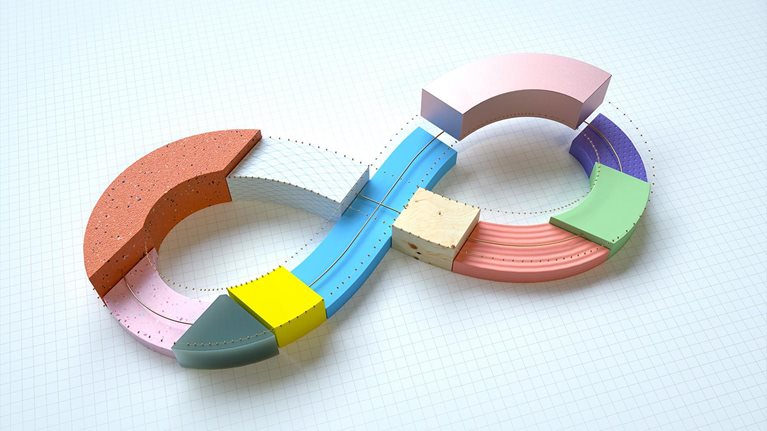
From product-led growth to product-led sales: Beyond the PLG hype
- Home > Publications > Customer Journey Mapping in B2B Markets: A Comprehensive Guide
Customer Journey Mapping in B2B Markets: A Comprehensive Guide

Customers are organizations’ biggest asset – without customers to buy products and services – there is no business at all. In recent years, customer experience has become a focal point for organizations, to encourage customers to spend more, pay a premium for that service, and recommend the supplier based on the experience it delivers. There is a strong correlation between poor customer experience and switching suppliers for better experience and service, and therefore understanding the journey that customers go through, and where improvements could be made – is now commonplace in many organizations.
What is Customer Journey Mapping?
To understand the current customer experience, it is essential to map the touchpoints that customers go through with the supplier. Through doing this, we can then build an understanding of where the customer might be facing points of delight or frustration, which can help organizations to drive improvement for customers.
A customer journey map is a visual representation of these customer interactions with an organization. To effectively build the map, it is crucial to step into the shoes of the customer to try and understand how our processes impact on the experience that the customer has with the supplier. That is – not only what might encourage the customer to make a purchase, but what emotions they are feeling at each stage of their journey with a supplier, as we know that emotions are a top driver of loyalty to a brand (even over aspects of the journey like ease of business).
It is a blueprint for the journey taken by the customer, marking all touchpoints. It should extend from touchpoints designed to raise awareness and interest – including advertising and marketing efforts, PR, etc. – through to the touchpoints associated with usage e.g. sales reps, accounts teams, support services complaints handling, etc. It should also extend to the cessation of the relationship with the company e.g. closing a bank account, switching to an alternative provider, etc. as the handling of this stage can be critical in turning around experiences and inviting future return to usage.
A Customer Journey Map (CJM) should therefore include:
- A flowchart or diagrammatical representation of the journey which customers take.
- All interactions and interfaces (touchpoints) between the customer and the company/brand
- Likely “pain points” in the journey i.e. areas where the customer is likely to experience difficulties or negative emotions.
- Key “moments of truth” i.e. areas where there is the opportunity to “make” or “break” the relationship.
Once maps have been developed, it is also common to then populate them further, to include:
- Identification of departments, regions, and people responsible for the delivery of the customer experience at each touchpoint (e.g. customer service, technical support, HR, sales and marketing, etc.)
- Linkages between touchpoints
- Emotions elicited and desired in the customer at each touchpoint.
- Importance ratings for each touchpoint. This can include looking at the internal perception of importance compared to customer measures.
- Performance of the company/brand at each touchpoint. As with importance, the gap between the internal and external perception can be identified.
Customer journey mapping is evolving to be more sophisticated in driving action. The use of AI in customer journey mapping is on the horizon, to allow us to more accurately predict customer behavior based on past data – which can in turn help organizations to improve customer experience and satisfaction through anticipating what the customer will need. It is certain that customer journey mapping will be even more relevant to drive customer satisfaction and retention in the future.
Contact Us >
Why Conduct Customer Journey Mapping?
Most large corporations operate in ways which separate different functions of the service delivered to its customers e.g. ordering, technical support, complaint handling, warranty claims, general inquiries, etc. This is generally felt to be necessary to build expertise and manage operations. However, unless the various functions are joined up, the customer can feel this disconnect or even fall between departments or functions. By tracking and describing the customer’s experience at each stage of this ‘journey’, a company is able to:
- Deliver seamless, streamlined products and services that cut across departments within the company.
- Tailor services to meet the needs of both customers and the business.
- Understand the experiences, thoughts, and feelings of customers.
- Develop compelling propositions.
Customer journey mapping has obvious advantages within a company, not least in developing a customer culture and the internal buy-in with the brand. Customer experience journey mapping exercises focus the business on the customer. Simply by spending the time considering what the customer’s lifetime experience is with the company highlights the strategic positioning the customer has within the company, the customer culture, and the degree to which the customer is considered in service design and delivery. This can help to unite siloed departments or teams on improving the overall experience of the customer, and how they can work together to do so.
In recent years, we have become more attuned with the importance of empathizing with customers’ emotions throughout the customer journey, as positive emotions and feelings towards suppliers are directly related to future purchases from the supplier. Customers with a stronger emotional connection to the supplier as well as strong satisfaction, are more profitable for suppliers. Along the customer journey, we should think about ways to measure and enhance the customer’s emotional connection with the brand.
To do this, we might want to include on our CJM:
- The baseline emotional state of the customer
- Examples of what could enrich the experience at each stage (resulting in a more positive emotional response)
- Examples of what would be a poor experience at each stage (resulting in a more negative emotional response)
Many brand strategies are developed in the absence of the customer and yet it is the customer who lives the brand. Their perception of the brand comes not only from the messaging, imagery, and promotions, but also from the experience they have with the company and its products. Whilst this philosophy can now be seen in the imagery of the mass promotional campaigns of some leading brands, it must be backed up by the experience delivered when interacting with the supplier. A company that understands the customer journey in detail is able to design “ideal” experiences and orientate the operations and the people delivering these to engage its customers with the brand and build loyalty.
Moreover, we have seen that in recent years, especially since the Covid-19 pandemic, that customers’ expectations of the brands that they work with have increased. This has resulted in a gap between what the customer expects from the brands they are working with, and what can realistically be delivered by the supplier. To narrow this gap, it is critical to highlight where the gaps are largest between expectations and experience when customer journey mapping – organizations need to be prepared to meet expectations as closely as possible to avoid this ‘customer expectation gap’ growing larger.
Figure 1: The customer expectation gap
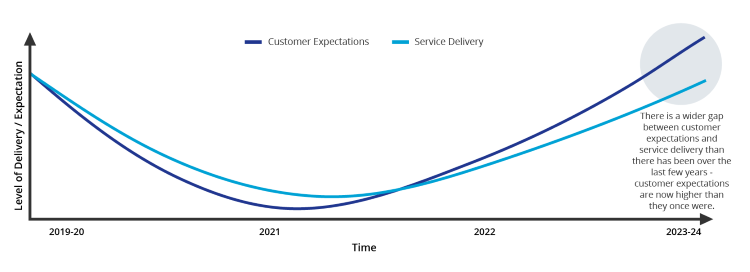
Problems and Pitfalls with Customer Journey Mapping
Customer journey mapping and touchpoint analysis is not without its problems. Knowledge and perceptions, both internal and external, are required to develop the Customer Journey Map, particularly in more complex B2B markets. Pitfalls which can be experienced when embarking on the process can include:
- Getting buy-in from senior management.
- Getting co-operation from staff who are responsible for the various elements of the customer journey (and aligning on actions based on customer journey mapping)
- Availability of resources to undertake the process, and drive action based on research findings.
- “Blank sheet syndrome” – having difficulty getting started.
- Lack of understanding of customers’ emotional connection with the brand and how to tap into this.
- The complexity of customer journeys – every customer can take a different journey, so maps can be complex!
Types of Customer Journey Maps Used in B2B Markets:
Customer Journey Maps can take several forms, depending on the needs of the business and the extent to which business processes are incorporated into the map.
Typical customer journey mapping:
A map that provides a strategic overview of the stages of the B2B customer journey, along with the component B2B touchpoints where a customer can interact or engage with the company at each stage of the journey.
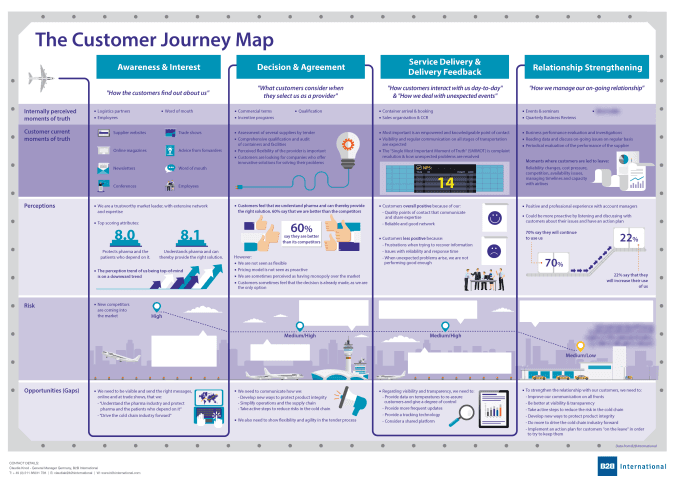
Tactical customer journey mapping:
The tactical B2B customer journey map focuses on a particular touchpoint (or cluster of B2B touchpoints) to highlight the journey that the customer goes on at that stage. This is particularly useful when looking at an important (or painful) touchpoint where performance needs to be at a high standard. Tactical maps can also be a useful tool for training teams that are responsible for a particular stage of the customer journey.
The performance map is similar to the tactical journey map, though it goes into more detail about the performance at each step of a process, and provides key recommendations at each stage. These are invaluable when identifying “pain points” and “bottlenecks” for the customer, and identifying how processes impact on customers. Therefore, they can be very useful for circulating information to those responsible for making the improvements on a day-to-day basis. These maps can also be helpful to design touchpoint research or surveys, to measure performance trends at the ‘painful’ touchpoint.
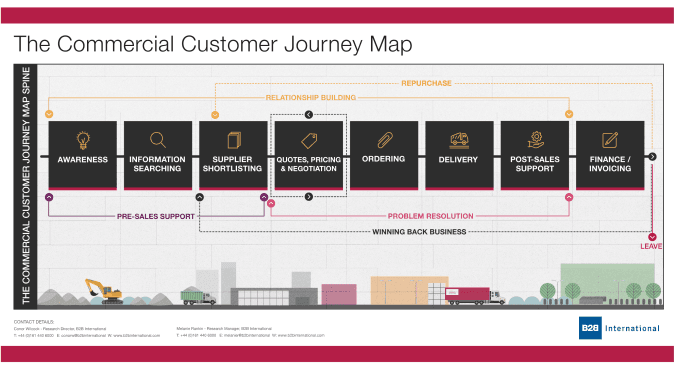
The Customer Journey Mapping Process
A customer journey map details all the individual touchpoints and interactions that customers have with a specific business.
Whilst all customer journey maps are unique to a business and its different customer groups, the process in creating these journey maps is broadly the same. If an end-to-end customer journey map has not been created, then it can be useful to map this out starting with how a customer becomes aware of a business or brand (such as through the website or a word-of-mouth recommendation), right through to service delivery and ultimately, what happens at the point at which a customer wants to exit the relationship or indeed, return and continue doing business. It might even be useful to consider the emotions and the processes that the customer goes through before they start to research brands (e.g., what problem(s) would the product or service be solving?).
Alternatively, a business may want to instead focus on one part of the customer journey (rather than the end-to-end journey) to understand this better and to explore this in more detail. As an example, if a business is happy with the sales process upfront but is more concerned about understanding the after-sales customer experience, then it may wish to build a map to explore specific interactions that occur at this point in the journey to examine where they are performing well, where there are potential problems or customer “pain points” and which departments are responsible for owning each of these specific customer interactions or experiences.
A key point to bear in mind is that the focus should always be on the customer, i.e. the customer journey map must be produced through the lens of a customer. In other words, it should represent the interactions the customer sees and experiences, rather than the internal processes that may occur behind the scenes within a business, which the customer does not see. For example, a customer may order a product for delivery, but they might not see how that order is specifically processed by the organization internally.
Creating the customer journey map
Depending on the industry in which a company operates, the range of its operations and the type of products and services it offers, the starting point will be to define the different groups of customers and to establish how different their “journey” with the company can be. Typical approaches to customer experience journey mapping here are to segment B2B customers on firmographics (i.e. classifications which make them different such as geography, age, SIC code), behaviors (i.e. what they buy) or needs (what they are looking for). This exercise is required before any journey mapping can take place. It may even be the case that these customer groups are overseen by different departments within the organization; in some cases, it makes sense to create multiple customer journey maps to avoid data overload.
The next step is to map the journey of each of the customer segments from end to end, detailing all the customer touchpoints with the company, and the customer responses to these.
The key overarching stages of the customer journey form the “spine” of the customer journey map. Under each key stage of the “spine” is where you list all the individual touchpoints or interactions a customer may have at that stage. Touchpoints may have connections with different stages of the “spine”, depending on the journey that the customer is taking.
As an example, under the “awareness” stage of the spine, the individual interactions a customer may experience in becoming aware of the brand may include some or all of the following:
- The company website
- Social media
- Trade publications
- Word-of-mouth recommendations
- Branded vehicles or delivery trucks
- Seeing the brand at sponsored events
Post-it notes and flip charts (or similar) are useful for capturing all this information. We would always advise that one post-it note is used for each touchpoint, as when doing this as an internal group exercise, then you will likely want to add or remove individual touchpoints, or potentially move these around or group them together. The key here is to keep reminding yourself that these touchpoints should all represent experiences through the eyes of the customer and so if a customer does not experience it (i.e. it’s an internal process they do not see), then it should not be included.
Heat-mapping performance
With multiple touchpoints and interactions mapped against each key stage of the “spine”, a customer journey map can shed light on the hundreds of specific interactions a customer can have with a business. Knowing what these are is a vital basis for formulating a plan or allocating resources appropriately towards effectively managing the customer experience across these different interactions.
However, a useful exercise in helping a business understand where attention is required, is to heat-map performance of these touchpoints. Once again, it’s important to put yourself in the shoes of the customer and then decide (either in groups or individually) which touchpoints can be classified into the following:
Customer pain points: Those touchpoints where there are challenges faced by the customer or where a business feels it fails to meet customer needs and expectations now. This point is important given how crucial customer emotion and brand connection is for customer retention.
Moments of delight: On the flip side, those touchpoints where a business feels that it delights customers by doing a good job or exceeding their needs or expectations.
Moments of truth: The touchpoints which are the most important or critical because they have the most impact on the longer-term loyalty of a customer. These points in the journey map can simultaneously be pain points or moments of delight.
When heat-mapping, it is not necessary that every single touchpoint is classified into one of the above and some may be left blank because they could be somewhere in the middle – neither a pain point nor a moment of delight. Equally, it is ok if some touchpoints are marked as a pain point and a moment of delight as well as a moment of truth, since this might represent that this touchpoint is important, but there are extreme inconsistencies in the experience of the customer here.
Of course, this exercise captures an internal perspective only, so it’s important to also test this out by speaking directly to customers. By doing this, it can be a powerful catalyst for change to conduct gap analysis on what we think internally versus what customers feels in practice. These insights can be used to help a business prioritize its resources on where these are needed most and where these could have the most positive impact on longer-term customer loyalty.
To overcome the barrier of the mapping exercise being based on internal views only, validating the customer journey map by speaking to customers allows us to better understand the sentiment that customers feel at the various stages of the customer journey, as well as giving us the ability to understand variations in the decision-making unit at different points in the customer journey. We can ask customers about changing dynamics in the decision-making unit throughout the journey, as well as when something goes wrong, for example. Customers may not travel through a linear customer journey map, so it is useful to understand discrepancies and variations in the customer journey taken, and the impact of these on the customer.

The role of internal employees and customers in customer journey mapping
Customer experience journey mapping can be done using a variety of methods which engage stakeholders involved in the process, and ensures their input into the development of the maps. A combination of workshops, staff interviews or focus groups, and customer interviews are normally used. These are then validated externally with customers (current, potential, and sometimes lost) to ensure the maps encapsulate the customer experience, and no critical touchpoints are missing.
Sessions can be conducted either in-person or virtually, so that we can capture as much knowledge as possible, even when teams are spread across the globe. We can use virtual whiteboards to map the journey, and encourage participation from everybody in the session. There is often some debate on what the journey looks like when sessions are conducted, whilst teams try to align on what the experience of the customer looks like, how they experience the journey, and which touchpoints are painful, positive or moments of truth.
Internal workshops (usually senior management) can help to:
- Establish a high-level view of the customer journey
- Establish buy-in at senior level
- Start thinking about things from the customer’s point of view
Internal interviews (usually departmental) can help to:
- Validate the high-level map
- Ascertain more touchpoints at particular stages
- Understand pain points and important touchpoints
Customer (current and/or lost) input – interviews and focus groups can help to:
- Validate the journey both in terms of stages and touchpoints
- Understand important touchpoints for customers
- Understand pain points for customers
- Understand gaps in internal vs. external perception
- Highlight expectations so we can estimate the customer expectation gap
- Understand feelings at each stage of the journey (when things go right, and when things go wrong)
- Demonstrate how decision-making units can change throughout the customer journey
Visualizing the Customer Journey Map
As customer journey maps can be complex, it is critical to design a clear visualized map that can be understood and used across departments.
There are a variety of ways to design the customer journey map to make the data simple, clear, and actionable. You may choose to use:
Large posters which can be placed in offices or other places of business to encourage engagement of all staff in the customer experience
Booklets which can focus on different personas or customer types through the customer journey
Excel spreadsheets or detailed tables of the customer journey (especially for customer experience teams who need the detail to drive improvement in the customer journey)
Digital outputs such as interactive infographics or videos, which can be shared across teams and/or regions. These outputs are especially useful now with online and hybrid working being common practice – staff can still be engaged in customer journey and experience improvement without being in a physical workspace.
The Value of Customer Journey Mapping & Challenges in B2B Markets
Customer journey mapping is just one stage in the move towards a customer centric approach. It marks the starting point; placing the experience of the customer at the heart of what the company does and how it operates. It provides a single overview of how customers interact with the business, focusing the company’s thinking on the customer and how the service appears from an external perspective. It is all too easy for large corporations to think in terms of departmental tasks, and so it facilitates cross-departmental working to understand the impact on the journey for the customer, and consider the “desired” emotional response from the customer at each point (as well as the impact if this desired emotional response is not achieved).
However, customer experiences, rather than being neat and linear, are often convoluted and complex, particularly in B2B markets where tendering, multi-site requirements, and technical product and service requirements often define journeys. These complexities can confound the customer journey mapping team, resulting in maps which are either overly complex or overly simplified, failing to capture the most important B2B touchpoints from the customer perspective and the emotional response to these from the customer. Resultant actions can then be process- rather than experience-driven.
The outputs from customer experience journey mapping deliver a tool for identifying outstanding and problematic areas, as well as “delight” and “choke points” in the journey. Using the customer experience management (CEM) process cycle (see below), the next stages are to design the “ideal” experience, put in place the processes and people addressed to deliver it, and develop a feedback mechanism to measure progress. As a result, valuable resources can be targeted where they will have the greatest impact for the customer coupled with efficiency for the business.
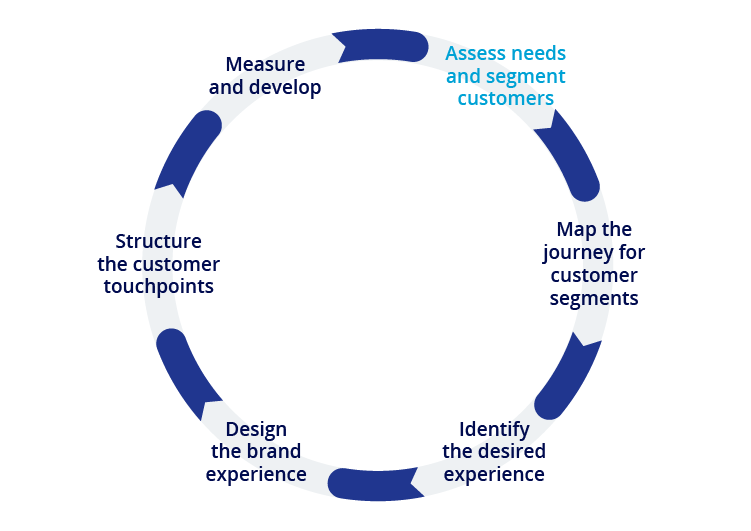
Customer Journey Mapping Best Practices
Customer journey mapping is an excellent tool to help an organization redesign its customer experience. It can help an organization piece together the current structures and processes affecting the customer and, by listening to customer feedback, identify gaps from the ideal experience. However, customer journey mapping is not an easy process, and getting it wrong can ultimately leave you with a lack of direction. Below are 5 tips to ensuring a successful project:
What does success look like?
You need to be upfront and clear about what your true objective is for undertaking the project, and this needs to be aligned within the business. This makes sure that the customer journey mapping work stays focused. Customer journey mapping can capture a wide range of information, and therefore it is important that the ultimate goal is kept in mind during the initial planning stages.
Identify complexities early
You need to think about your business and whether any intricacies in the way you operate will affect the journey mapping process. For example, different product groups or different customer segments may have different journey maps. The journey mapping exercise needs to take these into account, and it could be appropriate to design different journey maps to take these into account. Think about your customer segments before mapping starts!
Preparing for the workshop
Ahead of the workshop, enough groundwork needs to be done to make the customer journey mapping exercise run smoothly. You may want to hold stakeholder conversations ahead of the workshop to make sure there is internal alignment. You also need to ensure all of the right people are going to be present at the workshop – a healthy cross-section of different teams who are knowledgeable about the customer. You also want to have the right exercises in place that will ensure your output contains everything you were looking for. An interactive online whiteboard can be a useful tool to collaborate and get some ideas floating around before the customer journey mapping workshop itself.
Validating the customer journey map
As well as gathering the internal view, it is important to speak with customers to learn more about the processes from their experiences. It is often only necessary to do a small number of depth interviews to achieve this. Again, looking back at ‘what does success look like’ will inform the design. You may only need to speak to customers about a certain element of the journey, or speak to certain types of decision-makers to gather an understanding of customer sentiment, and identify where improvements can be made.
Visualizing the output
We would recommend that much consideration is given to the final output. Ultimately this is what you and your colleagues will be using to improve the customer experience. There are many creative ways that the map can be visualized – from giant posters, booklets, excel spread sheets or videos. It needs to be easy to understand, easily shared and can generate the actions you want.
Closing Thoughts
As a key element of Customer Experience Management, customer journey mapping is a “step back” exercise, and one which affords the opportunity to design truly innovative experiences which differentiate. It has real value in engaging staff at all levels within a business with its customers and their experience of the company and brand.
Customers are the greatest advocates of a brand or specific product or service: they tell stories and they make recommendations. They have the power to infect others with their enthusiasm for adoption, but also have the ability to influence against adoption, and hence focus on them is essential for long-term strategic growth.
Increasing customer expectations mean that it is more important than ever to understand customers’ emotions, behaviors and needs throughout the customer journey, to avoid increasing the gap between their expectations and what suppliers can realistically deliver. Understanding the customer journey in detail means that customers’ behaviors and next steps can be anticipated, and an experience can be designed to delight the customer.
Learn More About Customer Journey Research >
Readers of this article also viewed:
Customer Satisfaction Surveys & Research: How to Measure CSAT How to Determine the Strength of Your B2B Brand A 5-Step Framework for Driving Action and Seeing Results from your CX Programs
To learn how we can help your organization to create a customer journey map
Speak to an expert...
- Keep up to date with our latest research
- First name *
- Last name *
- Company name *
- By subscribing to this newsletter, you are opting in to our marketing communications. Read our privacy policy for more information.
- Email This field is for validation purposes and should be left unchanged.
Privacy Overview
- Gamification Engine Grow engagement with powerful gamification features
- Enterprise Ready Security, scalability, reliability and integration
- Financial Services
- Professional Services
- Travel & Hospitality
- Telecommunications
- Manufacturing
- Media & Entertainment
- Learning & Training
- Call Center Engagement
- Sales Motivation
- Channel Motivation
- Performance Management
- Development Teams
- Customer Loyalty
- Employee Onboarding
- Remote Work
- Community Engagement
- Product Managers
- Engineering
- Blog Catch-up with product, industry and company updates
- Infographics Collection of infographics with gamification insights
- Gamification Guide Step-by-step guide to learn in-depth about gamification
- Support Customer success and support at your service
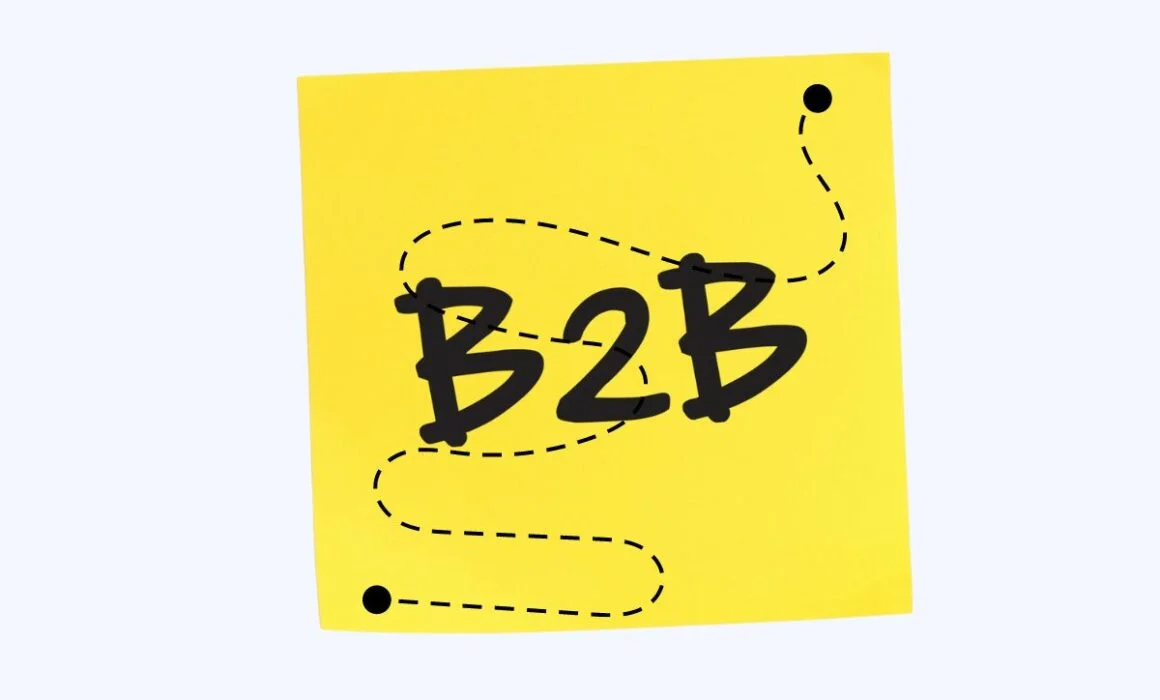
Mapping the B2B Customer Journey: Key Stages and Touchpoints
The B2B customer journey serves as a compass for businesses navigating the complex realm of buyer interactions and decision-making. Understanding the intricacies of this journey is crucial for organisations looking to build lasting partnerships and drive exceptional business outcomes.
A customer journey map helps B2B operators re-imagine their customer journey and deliver more personalised experiences. It presents a great opportunity to reinforce brand awareness and drive customer satisfaction.
This article explores B2B customer journey mapping, unravelling its key stages and touchpoints that pave the way to fruitful business relationships.
Table of Contents
How B2B and B2C customer journeys are different
What makes an effective b2b customer journey map, why you need a b2b customer journey map, #1. awareness, #2. consideration, #3. decision-making, #4. implementation, #5. support and relationship management, #6. renewal and expansion, awareness stage, consideration stage, decision-making stage, implementation stage, support and relationship management stage, renewal and expansion stage, define buyer personas, conduct customer interviews, analyse data and metrics, collaborate with sales and customer service teams, conduct journey mapping workshops, analyse competitor journeys, how to create interactive compliance training for bank employees, how fintech apps are using gamification to increase user engagement, top gamification companies for employee & customer engagement, gamification in gambling and online casinos, what is the b2b customer journey.
The B2B customer journey refers to the process that business-to-business (B2B) customers go through, from problem identification to post-purchase.
The process encompasses the entire lifecycle of a B2B buyer’s interactions with a company or brand. This includes their research, evaluation, purchase, ongoing relationship with the business and experiences along the way.
Consider a small business needing a scalable CRM (customer relationship management) solution, for example. There are many steps that it goes through before committing to a purchase. Even after the purchase, there are still post-purchase steps to cover, such as setting up the CRM system and providing after-sales services. That’s all part of the customer journey.
The B2B customer journey is characterised by multiple touchpoints across various channels. It is influenced by several factors, including industry-specific needs, organisational dynamics, and the involvement of decision-makers. Ultimately, the lasting impression of this journey is what defines the overall customer experience
Businesses and individual consumers approach the buying process quite differently. Understanding these differences is crucial for companies to tailor their strategies effectively to meet their customers’ unique expectations.
Some key aspects in which B2B and B2C (business to customer) journeys differ include:
- Target audience — As a B2B operator, you rarely buy or sell to one person. More likely, you’ll transact with businesses, organisations, or a diverse group of individuals composed of stakeholders, senior management, and end-users
- Complexity — B2B customer journeys tend to be more complex and involve longer sales cycles compared to B2C journeys. For example, B2B purchases typically involve higher stakes and larger investments, so there are often multiple decision-makers and longer negotiation processes.
- Decision-making factors — B2B customer journeys prioritise factors such as ROI, efficiency, scalability, and alignment with organisational goals. On the other hand, B2C journeys are frequently influenced by emotions, lifestyle preferences, and individual satisfaction.
- Relationship duration — B2B customer journeys typically involve longer-term relationships compared to B2C. This often necessitates continued engagement and support beyond the initial purchase. With B2B transactions, you look at ongoing partnerships, term contracts, or retainer arrangements.
- Personalisation approach — B2B journeys often emphasise customisation to meet the specific requirements of the purchasing organisation or target market segment. B2C customer journeys, on the other hand, may prioritise personalisation based on individualised experiences.
- Communication channels — B2B customer journeys typically involve multiple touchpoints across various channels, including direct sales interactions, professional networks, and industry-specific publications. B2C customer journeys rely heavily on digital channels such as websites, social media platforms, and online marketplaces.
What is the B2B customer journey map?
Simply put, the B2B customer journey map is a framework for capturing the customer experience. This visual representation illustrates customers’ pain points and their internal perception of the company throughout the business relationship.
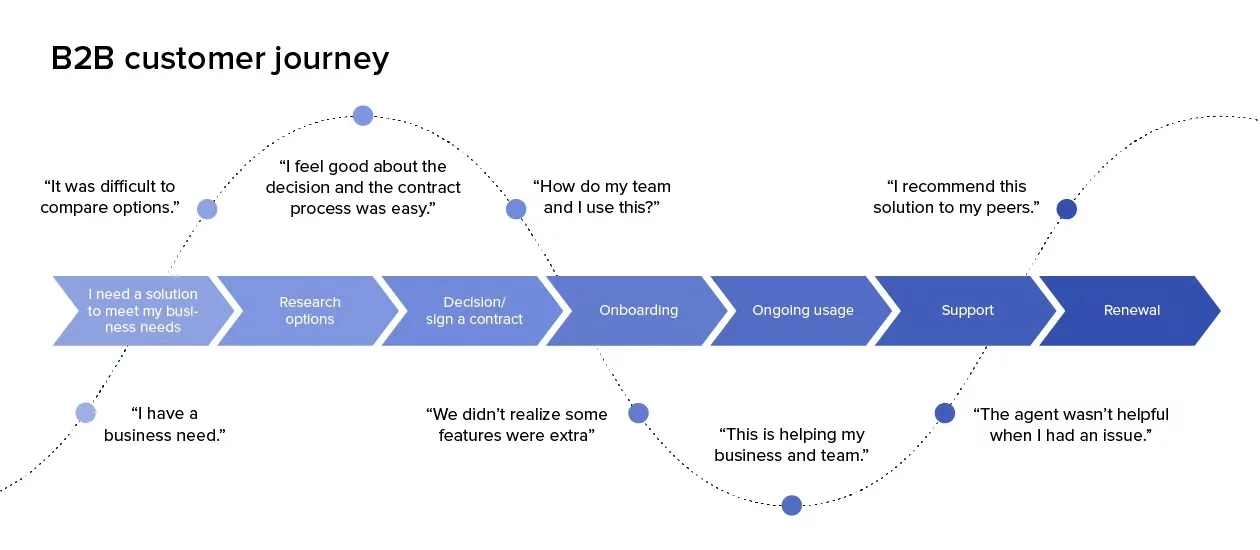
Source: apizee.com
These insights help the business identify areas to optimise to design and deliver more positive customer experiences.
Mapping the B2B customer journey requires a business to step into the customer’s shoes to see how its processes impact its purchase decisions.
The customer journey map is a blueprint for the journey the customer takes. This means it should be comprehensive enough to cover all the important touchpoints — from initial awareness to post-sale.
Depending on the type of business relationship, customer journey maps should also cover the cessation of the relationship with the company. How a business handles this stage can be crucial to minimising churn and encouraging future relationships.
Generally speaking, effective customer journey maps should include the following:
- A detailed flowchart of the customer journey showing the various interactions between the customer and the company
- Clearly outlined customer pain points or issues that may get in the way of a positive customer experience
- Identified areas where the company can take action to improve overall customer satisfaction
- Details about what departments or people are responsible for moving the customer relationship forward at each touchpoint
- Well-defined linkages between touchpoints
- The company’s performance at each touchpoint
Mapping the B2B customer journey gives businesses a powerful way to understand and cater to their customers effectively.
Here are the key reasons to design a B2B customer journey map:
- Enhanced customer understanding — A customer journey map provides valuable insights into the needs, motivations, pain points, and behaviours of your B2B customers. It helps you better understand their challenges, preferences, and decision-making processes.
- Strategic decision-making — A customer journey map helps businesses make data-driven decisions about their marketing, sales, and customer service strategies. It allows them to identify areas of improvement, optimise touchpoints, and align resources better to serve customers at each stage of their journey.
- Personalised experiences — A customer journey map enables a company to deliver tailored experiences to its B2B customers. This ultimately fosters stronger relationships and dramatically improves customer satisfaction.
- Alignment across teams — A customer journey map is a common reference point for different teams within an organisation. Marketing, sales, customer service, product development, and other departments can become more aligned and collaborative. This ensures consistent, cohesive customer experience across all touchpoints.
- Continuous improvement — Mapping the B2B customer journey is an iterative strategic process. It provides a framework for ongoing evaluation and optimisation of the customer experience to drive better business outcomes.
Key Stages of the B2B customer journey
The B2B customer journey typically consists of the following stages:
In this stage, the B2B vendor aims to raise awareness about what their business offers. The B2B customer, on the other hand, becomes aware of a need or problem they want to address. For example, the company might be planning to attend an industry event in another state. So one of the first things they’ll need to sort out is the transportation for their staff.
Now they’re aware of the need, so they start researching potential solutions and exploring available options.
As the name implies, this is where the customer “considers” their options. In the consideration stage, the B2B customer narrows their choices and evaluates different vendors or providers.
Here, they delve deeper into the features and benefits of each option. They may compare the prices offered by the shortlisted vendors and consider payment options, flexibility, and customisation. At the end of the day, it’s about arriving at an informed decision about who they will purchase from.
Having narrowed down their options, it’s time for the B2B customer to decide what B2B vendor to contact to initiate the buying process.
This is a pivotal moment in the B2B buyer journey. For one, it represents a successful conversion for the vendor, and is a sign that their lead nurturing methods are sound.
After the decision is made, the customer moves into the implementation stage. This involves the buying process, onboarding, and installation/configuration.
Depending on the product or service being provided, this stage may also include special training for specific staff within the B2B customer’s organisation. Once everything is properly set up, the customer integrates the chosen solution into their existing business processes.
With the solution fully implemented, the customer enters the support and relationship management stage. For instance, they might require ongoing technical support or they might be assigned an account manager to handle post-purchase concerns and requests.
This is the B2C equivalent of customer loyalty. In this stage, the B2B customer evaluates their experience with the vendor and decides whether to continue the relationship. Additionally, there may be opportunities for upselling or expanding the scope of services provided to the customer.
It’s important to note that the B2B buyer journey is not strictly linear. This means it’s not uncommon for buyers to move back and forth between stages based on their specific needs and circumstances.
Touchpoints in B2B customer journey mapping
The customer journey mapping process includes several critical touchpoints that occur before, during, and after a sale. Touchpoints are the various customer interactions or moments of engagement with a company throughout the customer journey.
Each one provides an opportunity for the company to leave an impression on the customer and ultimately impact their decision-making process. That’s why optimising touchpoints to deliver a consistent and personalised experience is essential in building strong relationships and fostering customer loyalty.
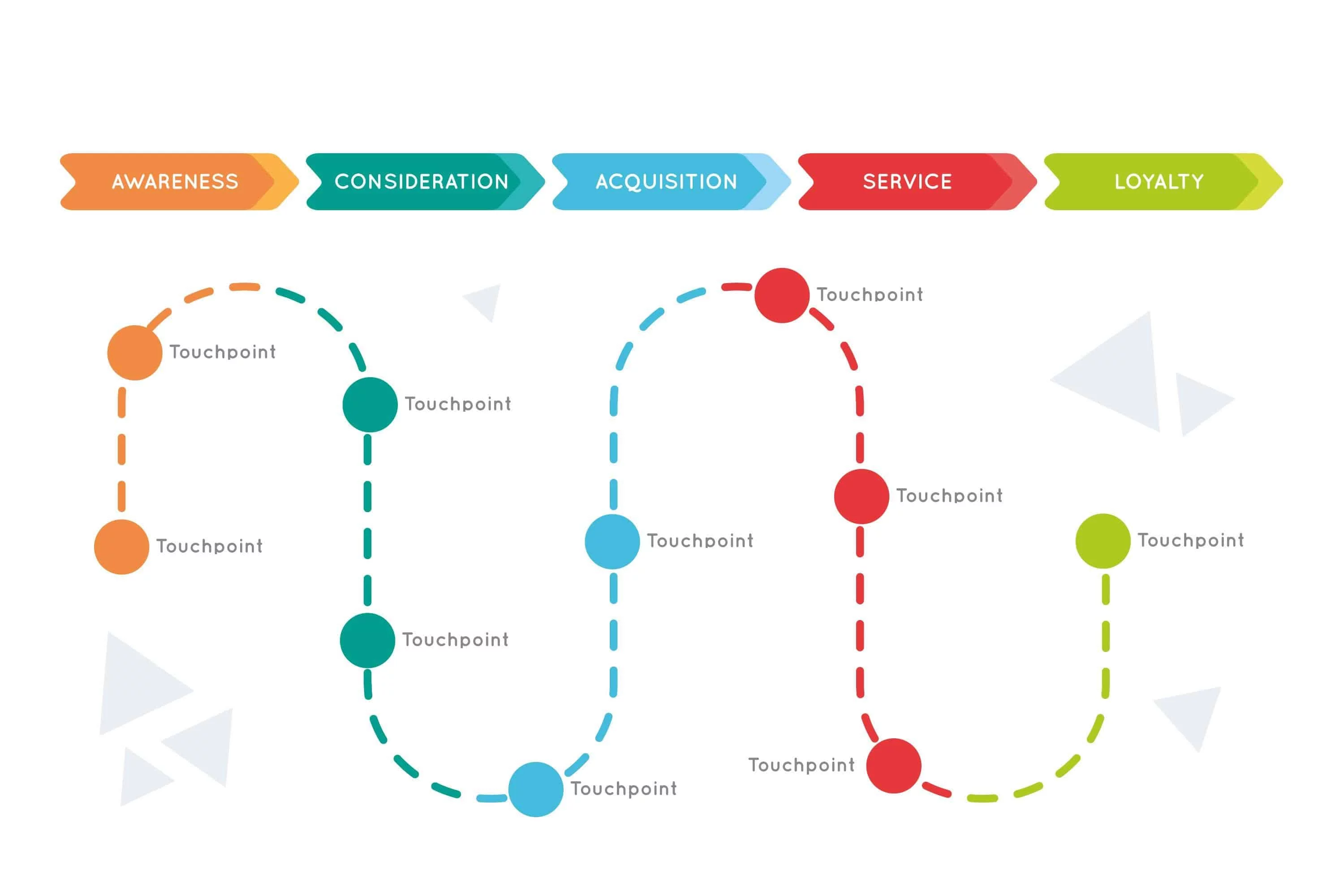
Source: salespanel.io
These touchpoints can occur through various channels, both online and offline, and are crucial in shaping customer experiences.
Customer touchpoints can occur at different stages of the buying journey. Here are some examples:
- Industry events and conferences — These events are great for learning about new trends, technologies, and potential solutions.
- Online research — Conducting searches on search engines and exploring industry publications and social media communities are great ways to facilitate customer interactions.
- Word-of-mouth referrals — Seeking recommendations and feedback from colleagues, industry contacts, or trusted sources make for great customer touchpoints.
- Company website and landing pages — Visiting the company’s website and landing pages to explore detailed information about potential solutions.
- Product demonstrations or webinars — Participating in live or recorded demonstrations and webinars to gain insights into the functionality and benefits of the offerings.
- Case studies and success stories — Reviewing real-world examples and success stories that highlight how the product or service has helped other businesses.
- Consultations — Engaging in meetings or consultations with sales reps to discuss requirements and solutions.
- Proposal and pricing discussions — Collaborating with the B2B vendor on contract terms and negotiating proposals that align with the B2B customer’s requirements.
- Reference checks — Seeking references from existing customers to validate the company’s reputation and track record.
- Vendor presentations or pitches — Attending presentations or pitches by vendors to assess their expertise and how well they understand the business’s challenges.
- Onboarding and training sessions — Participating in onboarding sessions and training programs to learn how to use the solution effectively.
- Technical support and guidance — Seeking technical support and advice during the implementation stage to resolve any issues that arise.
- Documentation and user manuals — Accessing comprehensive documentation, user manuals, and resources to support the implementation process and user adoption.
- Dedicated account managers or customer success representatives — A designated point of contact is great for nurturing current customers.
- Helpdesk or support ticket systems — Utilising helpdesk or support ticket systems to log and track support requests, ensuring timely resolutions. This is a key part of modern B2B customer expectations and is a leading factor in increasing customer retention.
- Surveys and feedback mechanisms — Providing feedback through surveys or related mechanisms to help the vendor improve their offerings and sales process.
- Contract renewal discussions — Engaging in discussions with the B2B vendor regarding contract renewal terms and potential adjustments based on changing business needs.
- Cross-selling and upselling opportunities — Exploring opportunities to expand the relationship by considering additional vendor offerings.
Mapping the B2B buyer journey
Customer journey mapping requires a thoughtful approach to design truly innovative experiences tailored to the B2B context.
It’s important to look for common pitfalls that typically accompany a journey mapping exercise.
Some businesses make the mistake of overgeneralising the buyer’s journey. This results in them creating a one-size-fits-all customer journey map that doesn’t account for the unique needs of different customer segments.
Another common mistake is focusing primarily on the sales stages and neglecting other key touchpoints of the buyer journey. This makes it difficult to capture the nuances of the buying experience truly.
The ideal customer journey map takes into account all the key stages of the journey with the view to achieving repeat business. It must also contain all the major elements necessary to improve customer touchpoints.
Check out the B2B customer journey map template below for an idea of the mapping process.
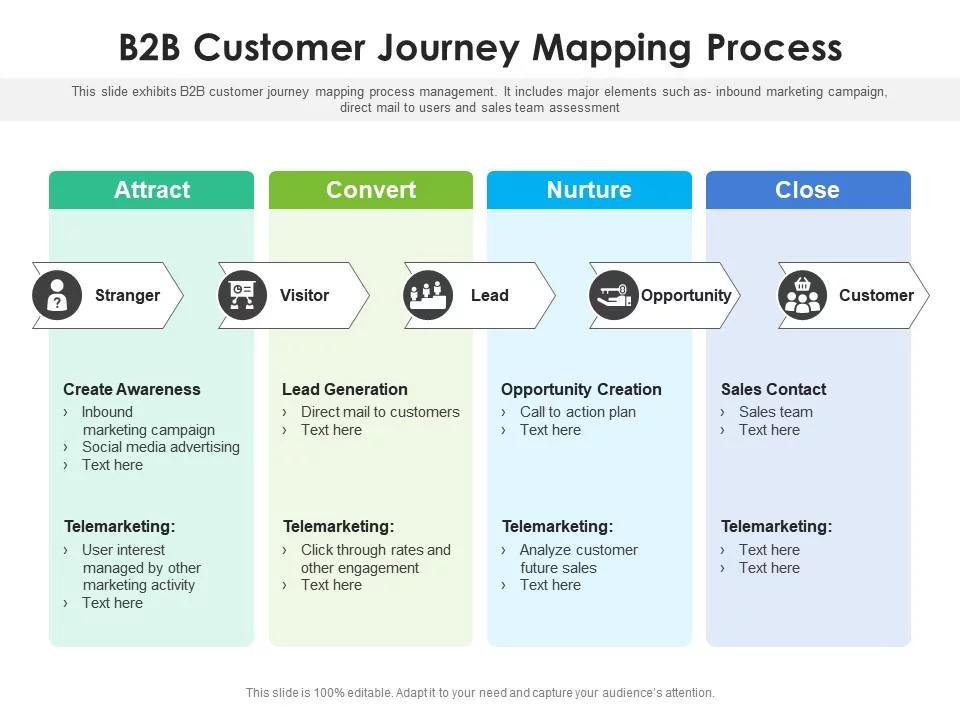
Source: slideteam.net
Here are some techniques you can use to map the B2B customer journey:
Start by developing detailed user personas that represent your target B2B customers. The most effective way to create personas is first to identify the pain points, motivations, and decision-making criteria of various customer segments.
This helps you understand their needs and tailor the customer journey map accordingly.
Engaging in one-on-one interviews with existing customers is a surefire way to gather insights about their experiences and interactions with your company. You can also collect customer feedback data through the usual tools — customer satisfaction surveys, feedback forms, focus groups, etc. This helps identify areas of improvement and shape the customer journey map.
Leverage data analytics tools to analyse customer behaviour, engagement metrics , conversion rates, and customer journey progression. This data provides a quantitative understanding of the customer journey and helps identify bottlenecks or areas of improvement.
Involving your sales and customer service teams in the B2B customer journey mapping process is important. They have valuable insights into customer interactions and can provide detailed accounts of the pain points at each journey stage.
Additionally, this collaboration can help buoy your marketing efforts and drive quicker outcomes.
Conduct workshops involving cross-functional teams from all relevant departments. Encourage brainstorming and collaboration to gain different perspectives.
Study the customer journeys of your competitors in the B2B space. Identify areas where they excel or fall short and use that knowledge to differentiate your own customer journey mapping.
Keep in mind that the B2B customer journey is not static, so regularly review your customer journey map. There will always be new customer insights, market trends, and changing customer expectations to incorporate down the line. This ensures your customer journey map remains accurate and relevant.
Download your free “Gamification Guide”
Get your PDF now and start transforming your approach to digital engagement!
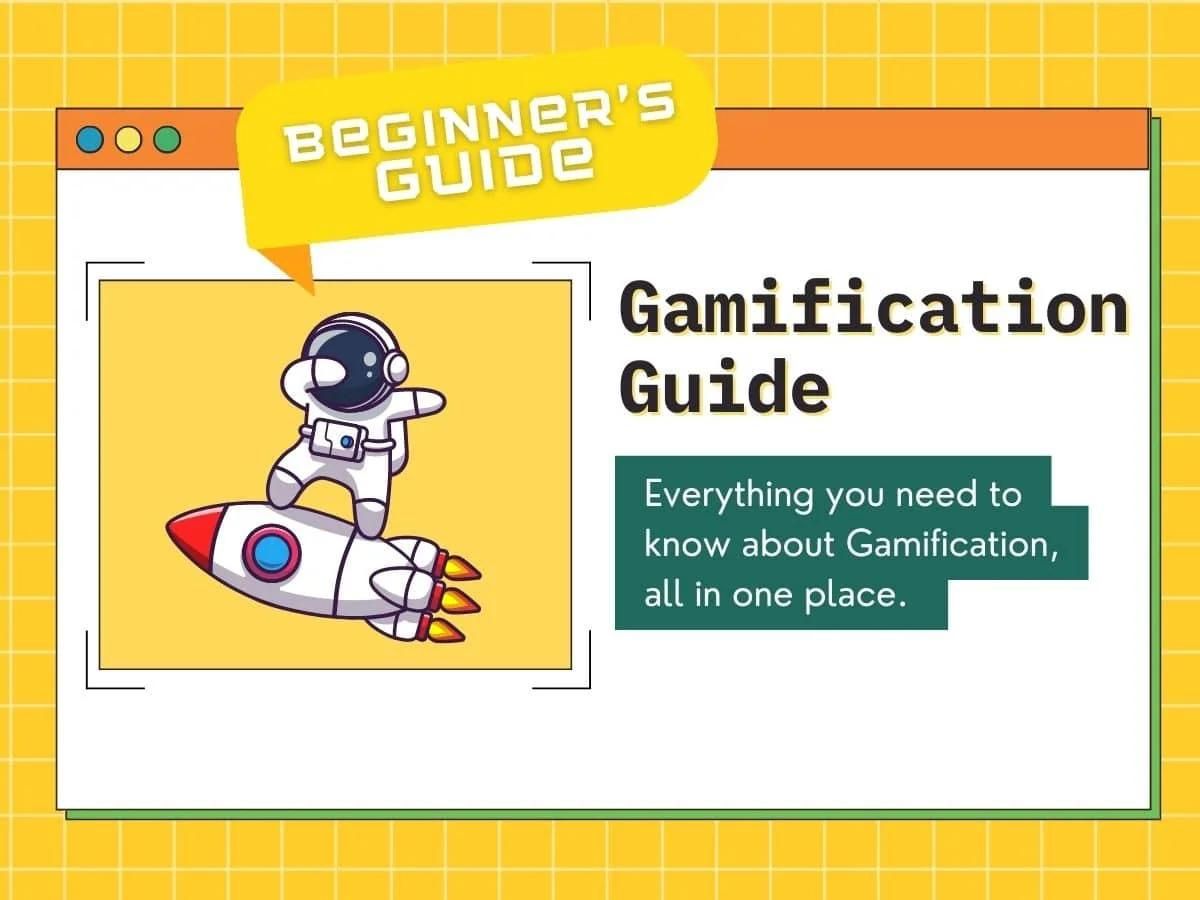
Mapping the B2B customer journey is an essential practice for businesses seeking to understand and optimise their interactions with customers. By comprehensively mapping the key stages and touchpoints, businesses can gain valuable insights into customer behaviour, preferences, and pain points.
Understanding the B2B customer journey enables companies to align their efforts to deliver a seamless and satisfying experience at every touchpoint. Ultimately, an effective B2B customer journey map serves as a roadmap for success, guiding businesses towards delivering exceptional experiences.
Latest Posts
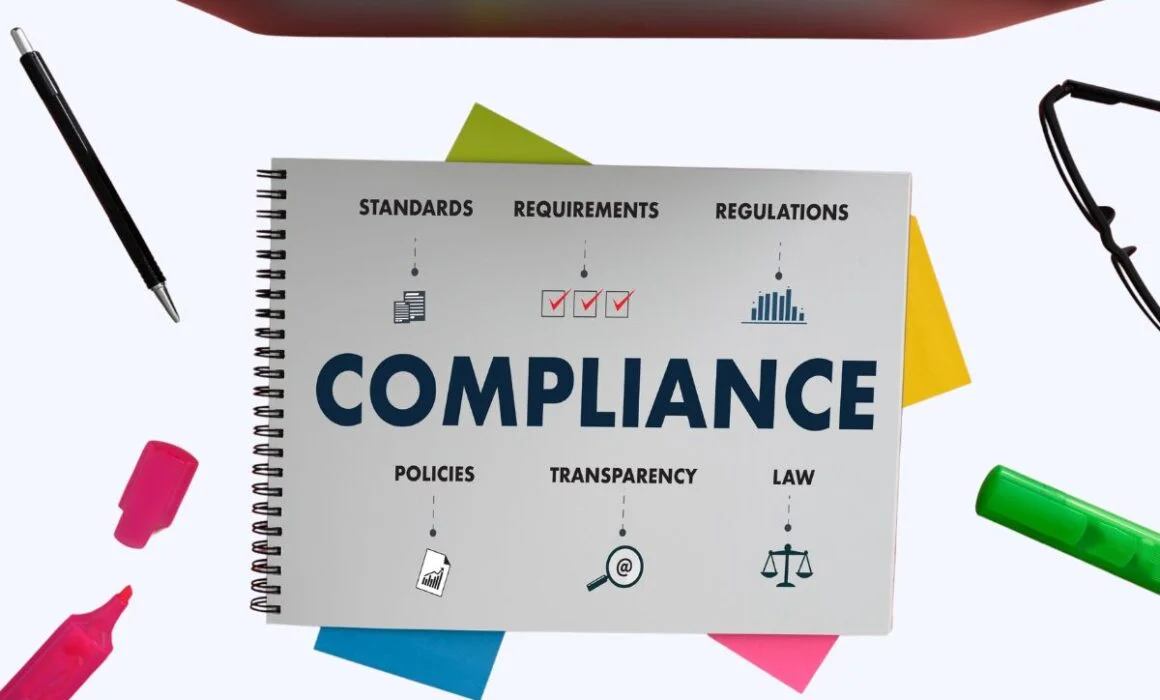
Banking compliance training isn’t just another task. It’s the stage where everything else performs. Banks must navigate a myriad of regulations and laws. After all, this is a trust-driven, high-stakes […]

Discover how gamification in fintech is revolutionizing financial engagement, making banking fun & boosting user loyalty.

Comments are closed.
- Case studies
- Expert advice
New template: telecom customer journey map
In the modern world, we can’t live without mobile phones and the Internet. Many of us stopped watching TV channels as they switched to streaming services . So troubles with the Internet connection create panic and drive us mad. No connection at all metaphorically sends us to a desert island.
Our new template will show you a telecom customer journey. We tried to capture their pains, goals, channels, and questions. We also figured out some ways to overcome possible problems.
A telecom customer journey map
Here’s a customer journey of a person who needs to be connected wherever they are. We started with the Aware stage and finished with the Feedback stage. Thus framed the full cycle of a customer's interactions with a provider. Yet, it contains all the moments that matter within any timeframe.
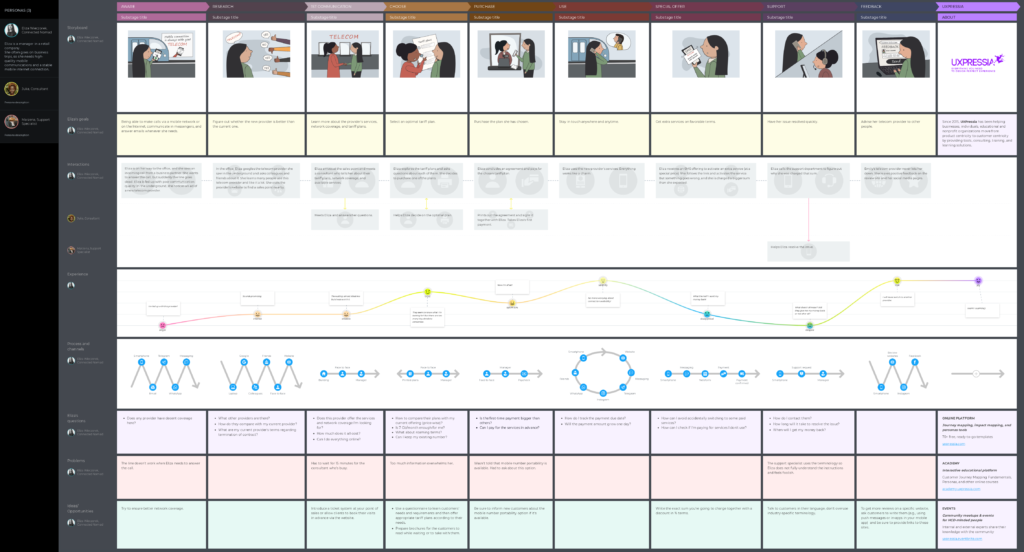
We developed a taste for uniting the narration, channels, and interactions in a single section. It’s illustrative and saves your time and effort. Be sure to try it yourself. And don’t forget to check out what opportunities we listed for you to improve the customer experience.
Eliza is a manager in a retail company. She isn't happy with the current provider and is searching for a better one.
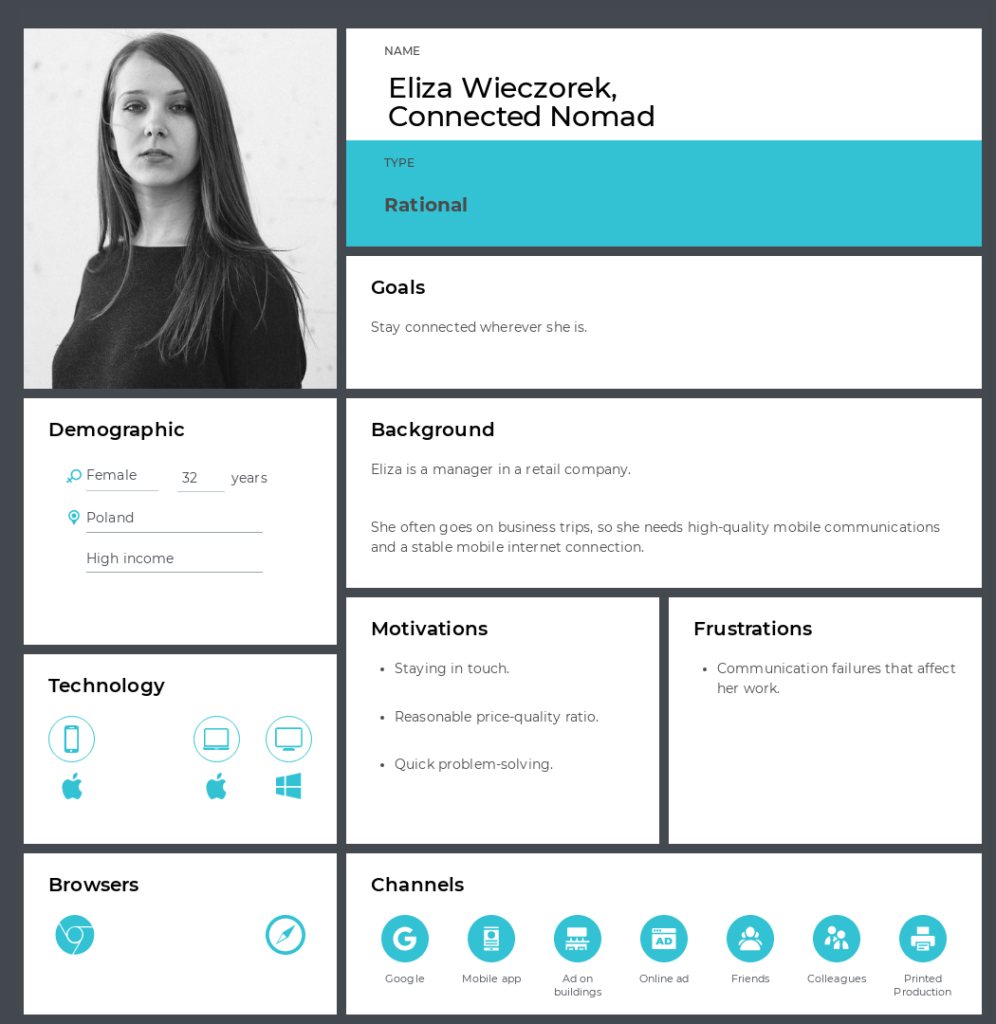
Look at the Personas section on the map. As you see, Eliza interacts with a support specialist Marzena and a consultant Julia. These personas are secondary but essential to map the real situation. Maybe you have more personas involved in your customer’s journey, feel free to create and add them here too.
Impact map
Following a telecom customer journey can give you useful insights into improving the customer experience. But how to map a measurable goal to come up with actionable initiatives? Try to build an impact map .
Say, you want to increase the number of new customers by 30% by Q4 2021. You consider potential customers too. Here’s what you can get:
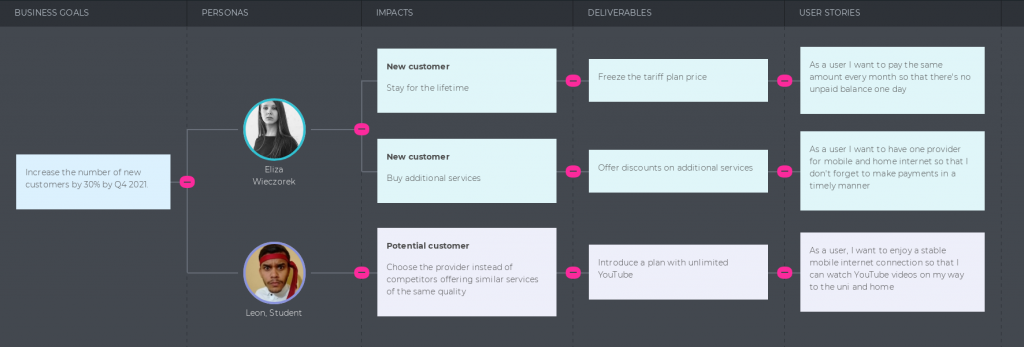
It’s compact and simple, the best format to build your particular case upon it.
Today’s a good day to design a telecom journey, don’t you think so?
Related posts
Rate this post
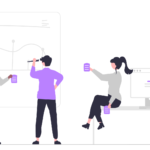
I find that the customer journey in telecom industry standards is pretty complex. You have multiple channels to cater, multiple products to sell, and younger customers with sky-high expectations to please. So looking forward to a template for a more complex use case.
I have to agree with Eloise. In telecom, customer journey management is often hindered by the overwhelming variety of product combinations, support not being able to keep an omnichannel front, and people ready to jump ship for another provider at the slightest issue. A very tough field to navigate.
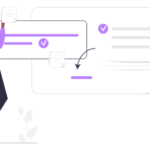
The B2B Customer Journey: Back to The Basics

The B2B customer journey is a complex matter, packed with a host of different touchpoints that affect customer experience. Understanding that complexity is essential in planning your customer service and marketing strategies.
So, how can you analyze your journey and go about improving it in the right way? We’ve come up with an essential guide to help you do just that.
- Definition of B2B customer journey
- B2B customer journey stages
- Difference between B2B and B2C journeys
- Building a customer journey map
- Improve your B2B customer journey
Let’s get started.
What is a B2B customer journey?
The B2B customer journey is the collection of touchpoints and interactions a customer has with a B2B company, from their very first encounter, all the way through to post-purchase.
Consider a B2B buyer who becomes aware of a SaaS software company that can address their particular needs, for example. There’s a whole load of other steps to go through before committing to a purchase. And even after purchasing, there’s still the setup, making sure they're getting the most out of it, and so on. That’s all part of the customer journey.
It’s the lasting impression of this journey that creates the all-important customer experience .
The B2B customer journey stages
The B2B customer journey stages consist of five main areas: awareness, consideration, conversion, loyalty, and advocacy. The exact stages may be broken down further or vary depending on the specific type of business (for example, some companies may require onboarding, or have multiple points of purchase).
Incredibly, throughout this whole journey, most B2B buyers spend only 17 percent of their time actually talking to you, according to Gartner's 2019 Future of B2B Buying Journey Report.
The rest of the journey happens "behind your back" — mostly researching and discussing with their team. That means that quality content is of paramount importance to give buyers access to the information they need to move through the stages.
The table below provides a general overview of how the B2B customer journey could look.

Difference between B2C and B2B journeys
The difference between B2C and B2B customer journeys is essentially that B2B customer journeys are more complex. And of course, they’re selling to different audiences.
That means that although the overall structure, running from awareness through to advocacy, is similar in both, behavior is guided by different motives in B2B. We can therefore make a number of distinctions. The table below shows some of the most important.

These differences impact how a B2B company goes about its business.
For example, in the case of selling to multiple people, when you’re talking to a non-decision-maker, it might make sense to talk about how user-friendly your service is, and try to give them the tools they need to make a business case to the decision-maker.
On the other hand, if it’s the actual decision-maker you’re talking to, you might want to think about a strategy that is much more focused on business results and KPIs.
6 Steps to building a customer journey map for B2B
Creating a customer journey map for B2C helps chart the stages your customers go through. It is a crucial first port of call in improving your customer journey, because it allows you to find touchpoints you had neglected before or bottlenecks that appeared. Here are six steps to help you create your B2B customer journey map.
1. Analyze typical buying groups
In a B2B environment, there are often multiple people involved, all with different roles and responsibilities. In fact, the typical buying group for a complex B2B solution involves six to 10 decision makers according to Gartner. And they’ll all have different requirements you’ll have to take on board. Make sure you understand their level of influence on buying decisions, too.
2. Understand your customers’ goals
What needs are your buyers trying to fulfill or what problems are they trying to solve? Take the time to get a handle on their motivations so you can better understand the value you’re going to provide.
3. Leverage data and analytics
Analytics is an extremely useful tool in your B2B customer journey arsenal. It can help you move away from making subjective decisions and ensure you instead deal in cold, hard facts. Use data from multiple sources like your CRM or customer experience platform to get a holistic view of the journey.
4. Build out the B2B customer journey stages
As mentioned previously, your precise customer journey map for B2B will depend on your business’ exact processes. To make things easier, it might help to start from a generic template (you can use the generic stage layout above), and then split that out into more complicated components as you go. It helps to put yourself into your customer’s shoes (perhaps assuming one of your buyer personas) and try to go through the B2B customer journey stages as an experiment.
5. Lay out the different touchpoints
Many B2B touchpoints, for example websites, blog content, and organic search, are shared between B2B and B2C. Others, however, are more specific to B2B. Demos, sales meetings, onboarding — you need to map all that. A digital customer journey may be more commonplace now, but don’t forget to take into account analog channels like print media, too.
6. Define your own goals
It’s useful to keep the end results you want in mind as you go through the process as well. Ultimately you’re going to want results in areas such as retention and customer satisfaction . Gather customer feedback and cross-reference your business analytics to see if you hit these goals.
Note : Depending on your company’s processes, it may make sense to have one customer journey map per major B2B client.
How to improve your customer journey for B2B
According to Gartner’s 2019 report, 77 percent of B2B buyers feel that making a purchase is very complicated and time-consuming. And, ultimately, that is bad for business. To minimize complications, make sure you optimize your B2B customer journey the right way. Here are some ideas to get you going:
- Create buyer personas. When we buy a product, what we’re really doing is ‘hiring’ it to help us do a job, according to Harvard Business School professor Clayton Christensen. A good place to start then is with a list of your customer’s jobs . What is it that they need to do? Consider factors like your contact’s position in their organization, their business needs, and their role within the decision-making process. These days, 60 percent of all B2B tech buyers are millennials (2 percent are even Gen Z) so this is definitely something to take into consideration.
- Stay focused on content creation. More than half of all B2B buyers view at least eight pieces of content during the purchase process, and 82 percent of buyers viewed at least five pieces of content from the vendor prior to purchase, according to Forrester. Make sure each piece of content is aimed at improving the customer journey and sets up the next action you want to see from your buyers to move prospects along the journey. Structure content around the issues that are most important to your customers.
- Identify and remove roadblocks. Make targeted interventions to remove friction and improve results by working backward to pick out anything from your customer journey that could get in the way of a sale. Factors nearest to the purchase point are often the lowest-hanging fruit.
- Qualify your leads properly. Don’t take any old form-fill to be a qualified lead. At the end of the day, pushing a lead through the process when they’re not ready is going to be damaging for everyone, your business included.
- Get onboarding right. Make sure your onboarding process is as smooth as possible. It will help you stand out from the crowd and lay the path for customer success.
- Stay front of mind. Nurturing current customers is crucial. Keep in touch so they stay engaged, update them on how things are going, and give them access to useful reports. And when it comes to renewal dates, make sure you send out timely reminders.
Learn from the B2C journey
Customer journeys tend to be thought of in terms of B2C. In fact, the reality is that in B2B, buyers are not only looking for but expect a buying experience like that of a B2C customer. And if there’s one thing B2C does well it’s personalization.
Yet, can you think of a time you’ve had a truly personal B2B interaction? To really stand out from the crowd with your B2B customer journey, always keep in mind that behind every brand logo are actual human beings.
What are your thoughts about the B2B customer journey? Let us know with a comment.
Looking to better manage your customer experience and gain greater insight into your customer journey? See what the Acquire platform could do for you by booking a demo with our team of experts.
Related Articles
B2B customer experience now vital in telecoms
In an age of heightened consumer expectations, the digitalisation of many organisations, the commoditisation of telecoms products, as well as the fallout from the global pandemic, have all had a profound effect on customer experience. Right now, in business-to business telecoms, CX has become the single biggest factor driving customer loyalty, and therefore revenue growth.
A number of factors are driving profound change. Many business leaders are getting younger, with Millennials and Gen Z rising through the ranks. These digital natives are raising the bar for operators. They are impatient and have zero tolerance for poor service, expecting to be served on their own terms, whether via self- or automated-service or through in-person service agents.
“Customer demand is changing massively, we now have a different generation moving into positions of power. If they don’t get a good experience they move their business elsewhere. At the same time, telcos are sitting on a lot of technical debt and legacy systems as they try to fulfil this need – this is why they need to get their act together relatively quickly,” says Dirk Grote, director industry advisory for communications EMEA at Salesforce.
Business-to business (B2B) players now show attitudes once reserved for the consumer market. Convenience and simplicity are key words. Heightened expectations are also rampant for enterprise customers all the way through to the small-to-medium enterprise (SME) sector. Telcos are being measured against the likes of Netflix or Amazon, which are completely unrelated businesses, yet they shape expectations globally.
“B2B buyers in the evening, when they stop working, become consumers. As they use a lot of these types of services there is then a higher expectation for personalised services. At the same time there is a cost pressure for telecoms providers. This is pulling them in the other direction. The question is how do you deal with opposing forces in a successful way?” says Sami Helin, global account director at Coveo.
A lot of long-established, incumbent telcos players have issues delivering one-to-one, customer services that digital-first, disruptive and data-powered innovators find easier to achieve. Legacy systems, complex product and service portfolios, across multiple acquired companies plague many telecom companies. The cost of transforming and unifying everything with customer data at the core would be too costly and take too much time. This can result in poor customer experience.
Customer demand is changing massively, we now have a different generation moving into positions of power. If they don’t get a good experience they move their business elsewhere.
“There are huge levels of remediation to be done. We’ve all experienced this. A lot of the telcos are trying to go digital-first. However, during the pandemic a huge mirror was held up to organisations. When contact centres were shut down and people were sent home, it was a very true reflection of an organisation’s capability. Customers experienced how good, bad or indifferent a company’s self-service and digital experiences were and how agile their operations were,” says Rob Allman, vice president for customer experience at NTT Ltd .
A shift to customer-centricity in B2B
However, telecoms providers are evolving at pace in order to answer the needs of their business customers. They are mapping out customer journeys, businesses better understand what customers want through market research, data analytics and feedback. There is a realisation that actionable data on customers is crucial if telecoms players are to up their game. In the B2B space, where there are a lot of complex services and products, it is also about knowing what to offer and when.
“People need to have an intuitive experience that is supporting their day-to-day rather than be bombarded with a tsunami of technology, which can create more suffocation than support. This is really important to bear in mind. We need to help human beings use the technology and not to be paralysed by it,” says Rukmini Glanard, executive vice president for global sales, services and marketing at Alcatel Lucent Enterprise.
The global pandemic was an acceleration event in this regard. It spurred on the adoption of more digitalised services, self-service and automation.At the same time, Covid-19 also revealed the lack of resiliency in many organisations, specifically in how telecoms providers engage with business customers and deliver differentiated experiences.
“It has provided impetus to think about things in a different way. The pandemic has certainly accelerated the consumerisation of the B2B space . It now has to be digital first. But it needs to be digital first in a way that the basic stuff is really seamless, the basics must work. Then you use human interactions to really augment the overall experience,” says Katy Pearce, head of customer experience at Vodafone Business.
One focus for Vodafone Business has been to assist SMEs, many of which had to pivot significantly when the pandemic hit, to become digital-only operators when routes to traditional market were closed. Some did not have a website, others had only a limited online presence. Covid shifted this sector dramatically, as well as boosted its dependence on telecoms services.
“Remember smaller businesses don’t have a whole IT department, they don’t have separate people that understand security, cloud services or connectivity. They are just trying to run their businesses. It’s therefore about helping these businesses use technology in the best way possible. The pandemic has been a massive wake up call, not just for telcos but for all businesses,” says Pearce.
The pandemic also created new challenges in B2B relationships for some telecoms providers. The shift to remote and hybrid working meant that fewer business mobile handsets and desktop phones were needed. If more employees use Zoom, Teams or Google Hangout, deploying more unified communications solutions, they don’t need as many physical devices.
“Even when businesses returned to the office they continued to use unified communications. This was a big challenge for us, if fewer people use phones we don’t need to produce as many. We had to be very fast and creative by inventing something new. For instance, we now have a cordless phone that connects via USB to a computer that employees can now use with Teams or Zoom,” says Jörg Brühl, senior vice president for marketing at Gigaset.
“Certainly, we need a lot more speed within our business cycles, we need the ingenuity and the excellence of our engineers to translate the demands of our customers into technology within our products.”
A vital year ahead for business-focused telecoms
Where are the opportunities within the B2B space for telecoms? If providers are to become trusted partners – which appears to be what all players want – they will have to add a lot more value, up their game, and provide more human-centred services.
The first hurdle is for telcos to make it easy to do business, by resolving problems and issues at lightning speed. No businessperson wants to spend days on a phone to a call centre to address a telecoms fault or get caught in an unresolved query online. Everyone wants their connectivity glitch dealt with instantly, otherwise it can cost corporations business and money.
“It’s about three things: simplicity, simplicity, simplicity. How do we make the user feel he or she is gaining time in their daily tasks? People don’t expect to fight against technology, they expect technology to adapt to what they need,” says Moussa Zaghdoud, executive vice-president, cloud communication business division, Alcatel Lucent Enterprise.
There were fears before the pandemic that telcos were becoming commoditised very quickly, where price was the main determinant for most products and services. Perhaps, Covid shifted the dial. Telcos now play a role similar to that of utilities companies; they are taken for granted, yet when they’re turned off, customers realise how crucial they really are.
The next year or so is therefore a key time for telecoms providers to prove they offer a vital utility, add value to people’s business and up their game. “The biggest opportunity coming out of the pandemic is the perceived relevance of connectivity. There is now a turn around when it comes to relevance. Everyone realises that telecoms are a lifeline for their business or consumer lives ,” says Grote.
Telecoms providers will need to be proactive in this process, contacting business users, mobilising data and providing a more personalised experience. “If there are issues, reaching out to customers and resolving them is crucial. People welcome that. This proactive approach changes the whole shape of the experience if you are on the front foot, and you are getting in touch with people. Trying to anticipate issues or points of satisfaction, renewal and potential growth; this is critical,” says Allman.
In the end, there is no difference between B2B and B2C we just have human relations that we are managing, and technology will help us to provide the best user experience
Certainly, the use of artificial intelligence (AI) and machine learning can help, as can a more customer-centric approach, where telecoms services and products are reengineered with the customer at the forefront and centre. Design thinking is crucial here.
“Smart AI technology can also now understand where everything is within legacy and siloed systems and can serve the relevant information to the customer. Telcos salespeople can now do their job better if they have access to real-time information about the customers, services and pricing. Customers can also have a consumer grade experience. Today, this can now be provided by machine learning without having to transform all of the back-end systems,” Helin says.
Telecoms providers can also learn from what has been deployed at the cutting edge of consumer markets and implement these strategies within B2B sales. Adding value will also depend on taking a more human approach to telecoms or specifically an augmented strategy where customer service personnel work hand-in-glove with technology platforms.
“We’ve just provided self-service to consumers, so why shouldn’t we do the same for business customers? They are also humans. In the end, there is no difference between B2B and B2C we just have human relations that we are managing, and technology will help us to provide the best user experience,” says Nils Stamm, chief digital officer for Deutsche Telekom.
Therein lies the opportunity for adding value in the business market for telecoms and customer experience, if providers are to become trusted partners they have to get the balance right between automation, agent interaction and delivering on what really matters to businesses.
It is a fine balance.
To find out more please visit coveo.com and salesforce.com
Want to read on?
Subscribe to our daily newsletter.

Move fast, think slow: How financial services can strike a balance with GenAI

Take on Tomorrow @ the World Economic Forum in Davos: Energy demand

PwC’s Global Investor Survey 2023

Climate risk, resilience and adaptation

Business transformation

Sustainability assurance

The Leadership Agenda

Global Workforce Hopes and Fears Survey 2024

The s+b digital issue: Corporate “power changers”

The New Equation

PwC’s Global Annual Review

Committing to Net Zero

The Solvers Challenge
Loading Results
No Match Found
Unlocking growth in the B2B telecom segment
Four basic building blocks to help transform the sector
Revenues across the telecom industry’s crucial B2B segment are slowly declining.
The needs and desires of buyers aren’t being fulfilled. Sensing opportunities for disruption, new competitors are circling, with capabilities that many incumbents can’t easily match. It’s no wonder that transformation has risen to the top of the agenda for telecom CEOs and boards.
Telecom operators know that to better serve existing customers, win over new ones, reverse declining revenues and stymie competitors, they will need a major shift in their capabilities and outward-facing identity. This requires transformation. But knowing the effort and investment involved in transformations, and the high rates of failure, how can telecom leaders improve the odds for success?
The four building blocks of transformation
At PwC, we’ve found that four building blocks are essential to every major change effort across all industries, including telecommunications:
Create a strategic identity.
Articulate a single desirable future for your enterprise and focus all your efforts on achieving it.
Design for trust.
Develop ways to attract and deserve the commitment of everyone related to your enterprise — particularly customers and employees.
Master the pivot from sprint to scale.
Test new practices in an intensive, experimental, startup-style manner. Pick the approaches that work, and rapidly implement them throughout the larger system.
Treat your legacy as an asset.
Save the best of your past, divest the rest for advantage and use the income to fund the future.
Build trust through outstanding customer experiences
Telecom companies need to design around the customer to create a better experience, embodying the trust that they seek to earn in the quality of that experience. Some of the ways in which telecom firms can achieve this include: moving beyond the one-size-fits-all approach to service delivery and customising the customer experience; presenting customers with proactive product recommendations; offering ‘freemium’ models, or try-before-you-buy products and services; and streamlining the contracting process.
Looking ahead
Achieving successful transformation for telecom companies is a challenging undertaking for any operator. But conditions within the B2B segment of the industry suggest that for many operators, transformation is not only inevitable, but increasingly urgent. The benefits of transformation are considerable, in terms of both cost reduction and revenue growth. And transformation will enable operators to leverage their legacy assets — their customer relationships and networks — in ways that they can’t today. The leaner, more agile and customer-centric telecom operator will be fit for growth in the difficult B2B landscape.
Download the full report (3.4mb, PDF)
Wilson Chow
Global Technology, Media and Telecommunications (TMT) Industry Leader, PwC China

© 2017 - 2024 PwC. All rights reserved. PwC refers to the PwC network and/or one or more of its member firms, each of which is a separate legal entity. Please see www.pwc.com/structure for further details.
- Legal notices
- Cookie policy
- Legal disclaimer
- Terms and conditions
Request Demo
- What is Net Promoter Score?
- How to Calculate Net Promoter Score
- What is Customer Retention?
- What is Customer Churn?
- What is Voice of Customer?
- What is Customer Experience Management?
- What is Customer Loyalty?
- What is Account Experience?
- What is Monetized NPS?
- Measuring Customer Feedback
- Acting on Customer Feedback
- Growing with Feedback
- Top Experience Management Software
- Top NPS Software
- CX Software
- Voice of Customer Software
Are you an agency specialized in UX, digital marketing, or growth? Join our Partner Program
Learn / Guides / Customer journey mapping (CJM) guide
Back to guides
A step-by-step guide to mapping the B2B customer journey (with real-life examples)
It’s tricky to effectively map out all the different user personas and purchasing processes in the B2B customer journey. But understanding your customer's experience is key to improving conversions and retaining users.
That’s why it’s essential for B2B companies to follow an effective customer journey mapping process.
Last updated
Reading time.
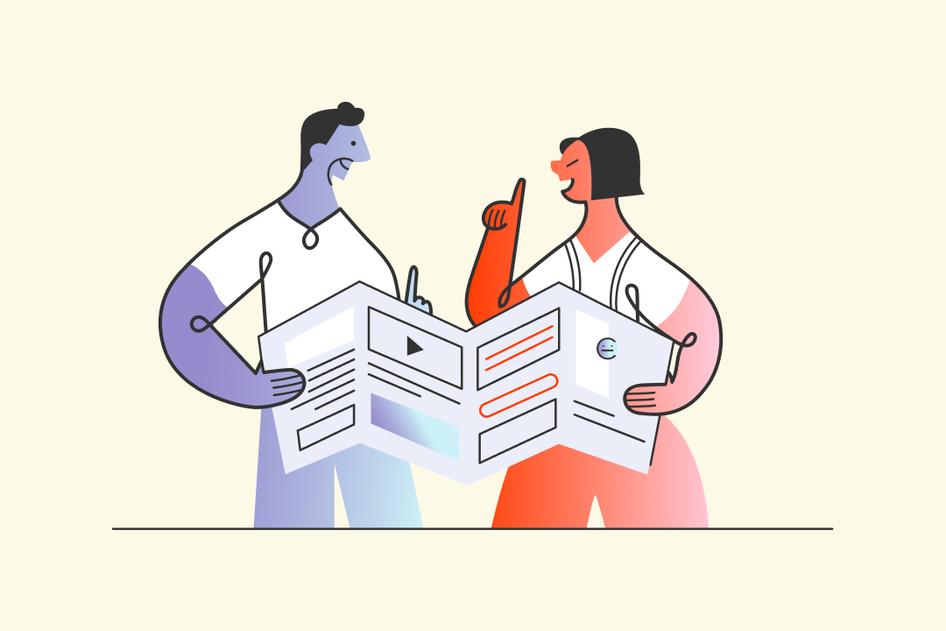
Use our step-by-step guide to create a map for your business-to-business (B2B) company that tracks your users’ unique journeys, giving you key insights into your customers and their needs.
Get valuable insights into your B2B customer journey
Hotjar helps you understand how buyers interact with key web and product touchpoints to improve their experience.
How to map out the B2B customer journey in 5 steps
Mapping the customer journey is essential in understanding your buyers and turning them into loyal customers.
Follow these steps to create an actionable B2B customer journey map that gives insights into who your customers are and helps you build an optimized user experience (UX) for them:
1. Set goals unique to your business
Before you start mapping out the customer journey, define your larger business and customer goals.
To begin, ask yourself what you want your customers to achieve—what are their jobs to be done (JTBD)? Does your business depend on repeat customers, or are your products one-off larger ticket items? Your customer journey will look different if you sell business clients a one-time-purchase product, like a hardware device, versus a subscription service.
For example, different B2B firms—like GE Renewable Energy and Hubspot—will have very different objectives. A company like GE Renewable Energy that sells large equipment to B2B customers may prioritize goals like generating more website conversions and creating brand advocates who recommend GE products to other businesses in the industry.
On the other hand, a software company like Hubspot will need to emphasize the customer journey's onboarding and renewal components to increase customer retention.
Know what your goals are before creating your B2B customer journey map to prioritize the most important steps for your customers and your business.

2. Identify your customer segments
The purchasing process is an especially nuanced cycle for B2B businesses, because the end users of your product or service are often not the same people making the purchasing decision .
John Forberger , founder of Forberger Communications , highlights this complexity:
Typically, multiple people have influence over a deal. Maybe one person researches how to replace a current tool, then a second person does a demo, and a third person actually cuts the check.
Don't just focus on the users who’ll try out your product or service, or on the C-level decision makers: understand every stakeholder involved in the purchasing process to map out an accurate B2B customer journey .
Consider the different needs of end users versus purchasers and think about how your user personas may differ depending on company size and type.
Take Canva, for example: the design tool is used by a variety of businesses, from freelancers to large corporations like PayPal and Danone. Understanding different user profiles and needs gave Canva the insight they needed to design their homepage for different B2B customer types who can choose their own adventure and head off on their most relevant user journey.
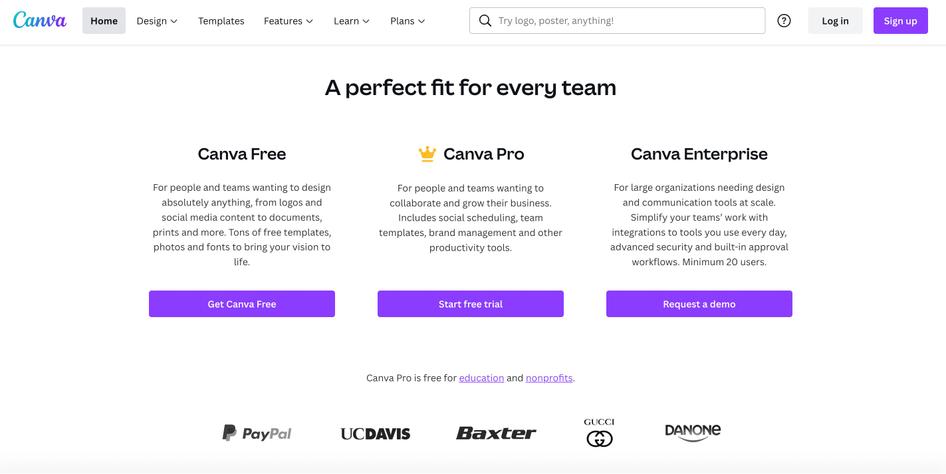
Pro tip: once you define your user profiles, learn more about different buyer types by asking the right survey questions . Use these questions to dig deeper into user goals and jobs to be done to better design the B2B customer journey.
3. Define the B2B customer journey stages
Once you have clear goals and user personas, it’s time to define the stages of the customer journey. Let’s take a look at a typical 7-stage B2B customer journey, using the popular SEO tool Ahrefs as an example.
Awareness: a buyer becomes aware of their problem and begins to search for solutions, which is when they discover your brand. In our example, a buyer knows they need to improve their website’s SEO performance, so they search for “best SEO tools” and come across Ahrefs. They visit the homepage, where the tool’s value proposition entices them to learn more.
Consideration: customers consider your product or service as a potential solution. Here, the buyer visits Ahref’s website and learns about the brand’s unique selling proposition , reads about features, watches a demo, explores resources like the Ahrefs blog and SEO guide, and weighs up whether Ahrefs is the product solution for them.
Decision: the buyer makes a decision and purchases the product or service that best fits their needs. In the case of Ahrefs, the buyer purchases the subscription (Lite, Standard, Advanced, or Enterprise) that’s right for them. The Ahrefs website guides users in the decision and purchasing process by displaying clear CTAs that encourage users to become paying customers.
Onboarding: the buyer starts to use the product, goes through the onboarding process, and gets familiar with the tool by reading guides and watching demos. They (ideally) start to adopt it into their everyday workflow.
Support: users contact customer teams as they need support. In our example, customers have easy access to customer support agents and the Ahrefs help center to smoothly resolve issues and questions.
Retention: customer retention is a key part of the B2B buyer journey, and at this stage, buyers decide whether or not they’ll remain loyal customers and continue using your product. Ahrefs offers a range of subscription models and gives users who sign up for an annual subscription a two-month free plan.
Advocacy: the final stage in an ideal customer journey is turning customers into brand advocates. Ahrefs has done a good job of this: the homepage shows reviews from real users who recommend the tool, including pro SEOs, content marketers, and agencies.
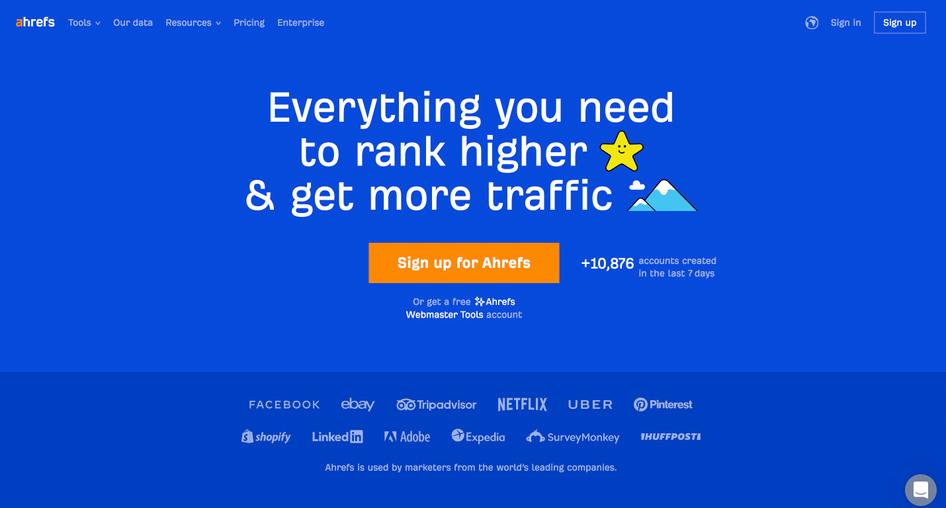
Pro tip: your product's user journey may look different depending on your company and customer types: a business customer purchasing a one-off product will have a very different journey from a company subscribing to a service.
Oleg Donets , founder and chief marketing officer at Real Estate Bees , points out how the stages of non-SaaS B2B customer journeys can differ from SaaS journeys :
"Since the vast majority of SaaS companies utilize subscription revenue models, this directly impacts the customer journey. B2B customer journeys often scale back a notch shortly after a sale has been made, but that’s when the customer journey of a SaaS company just starts kicking in."
4. List all possible B2B customer touchpoints
Once you map out the steps in your customer’s B2B journey, identify each ‘touchpoint’ where they interact with your company, from social media posts to your homepage CTAs and your product itself.
Let’s go back to the Ahrefs example.
A key touchpoint in the early awareness, consideration, and purchase stages of the B2B customer journey is their homepage and a clear call-to-action (CTA) button. These onsite touchpoints show customers what their next steps in the product experience (PX) should be and give them the information they need to make a decision.
In the next phases—onboarding and support—follow Ahrefs' example by making it easy for users to connect with your B2B business, resolve their issues, and upgrade. On the Ahrefs help center page, customers can reach out to representatives and receive support within minutes.
Make sure you continue mapping out how your users interact with your B2B after they become customers—in the retention and advocacy phases . How can you make it easier for them to renew their subscription? Do you offer any rewards for referrals?
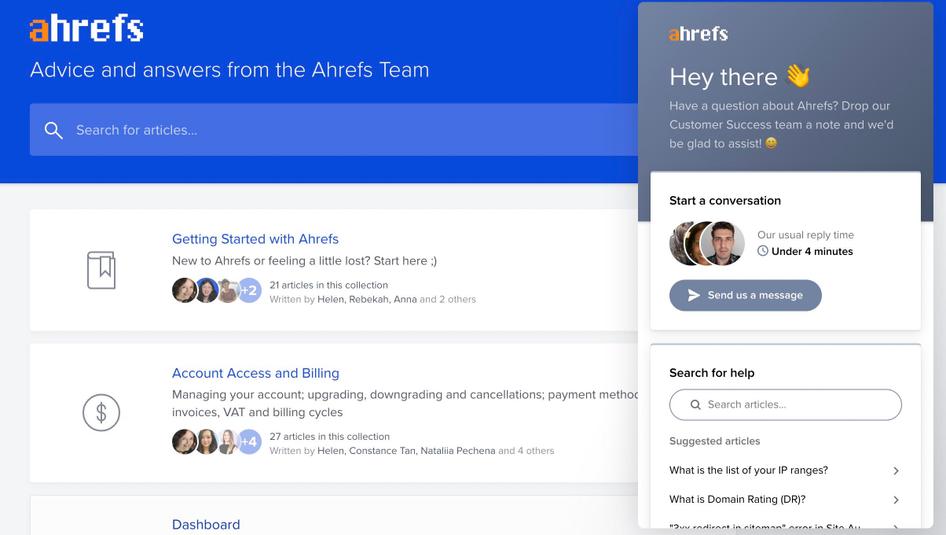
As well as mapping out touchpoints by customer journey phase, consider the different touchpoints experienced by different user personas.
For example, the product experience of high-level executives who make the purchasing decision may not be the same as their employees who are your end-users.
By identifying key B2B customer journey touchpoints for different customers and purchasing stages, you can improve UX, making product advocates out of your buyers.
Pro tip: use Hotjar's Observe tools—like Heatmaps and Recordings —to explore how your users interact with key B2B customer touchpoints on your website and product—and get the insights you need to improve their journey.
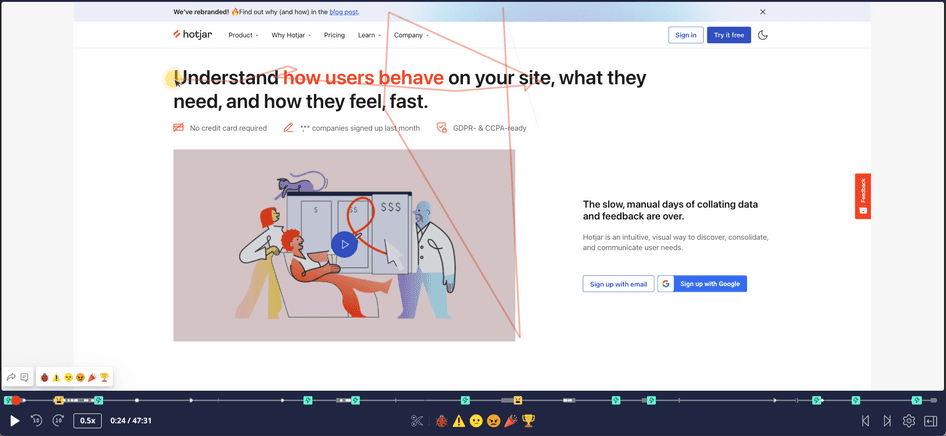
Hotjar Session Recordings show you how users experience your page to improve low-performing touchpoints
5. Measure and analyze the success of the customer journey
One of the most important customer journey mapping best practices is measuring the success of your customer journey.
Use the right customer journey mapping tools to help you evaluate the impact of your touchpoints. For best results, combine website analysis tools with software that offers more in-depth product experience insights and user feedback.
Use Hotjar's Observe tools to track how customers are engaging with your touchpoints. Then use Hotjar’s Ask tools—like Surveys and Feedback widgets—to learn what your users really think and feel about their B2B experience.
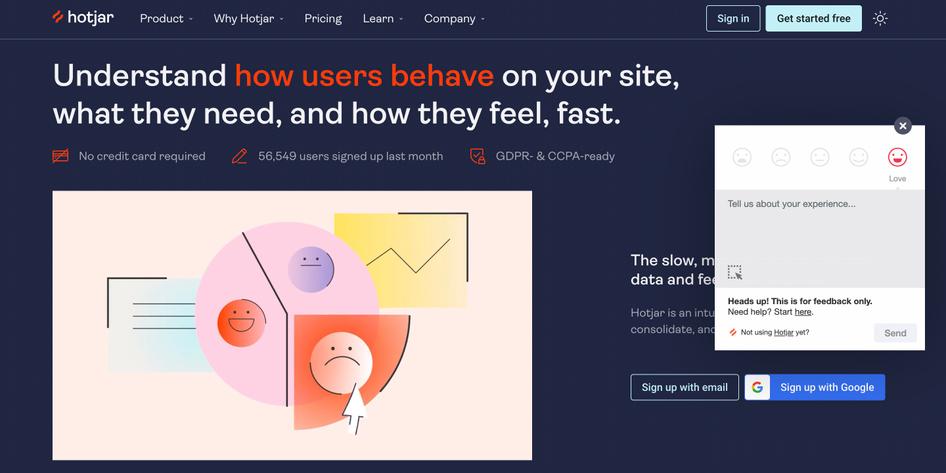
Tools like Google Analytics also help in mapping and analyzing the customer journey, giving you more general information on the types of users that visit your website and whether they convert or bounce.
Combine Hotjar with Google Analytics to dig deeper into B2B customer touchpoint insights to improve conversion rates and enhance the customer experience .
After you’ve mapped the customer journey, regularly check in on your key goals and what matters most to your customers. Keep measuring the outcomes of your customer journey to understand which aspects of the B2B customer journey are successful and what needs improvement.
Create a brilliant B2B user journey for happier customers
Successfully mapping out the B2B customer journey requires a deep understanding of all your buyers and how they interact with your brand and product.
Adapting these steps to your customers and company helps you create a customer journey map that identifies what your users need at each stage of the buying cycle to provide them with the best possible experience.
Use Hotjar to understand how buyers interact with key web and product touchpoints—and improve their experience with your B2B business.
FAQs about B2B customer journey mapping
Why do you need b2b customer journey mapping.
Visualizing the customer journey is the first step to understanding and improving it. B2B customer journey mapping helps you identify what type of experience customers have with your product at every stage .
Without B2B customer journey mapping, you won’t understand the process of converting potential buyers into loyal customers, meaning you have no way to make adjustments that enhance the customer journey.
How is the B2B customer journey different from other customer journeys?
With the B2B customer journey, there are often more stakeholders involved in the decision-making process than with a B2C customer journey. For that reason, the B2B customer journey is often much longer and depends on various decision-makers .
Plus, the B2B customer journey is often cyclical, as customer retention is such a key goal for many B2B companies.
What are some common mistakes of B2B customer journey mapping?
A big mistake in B2B customer journey mapping is failing to consider all user personas. B2B products often have a number of diverse customer profiles, whether that be different positions within one company (administrator vs. C-level executive) or different types of companies (like a small business vs. an enterprise).
Another common mistake is not taking into account the length and complexity of the B2B customer journey , which often has a lengthy approval process, and requires several different stakeholders to sign off on purchasing decisions.

CJM research
Previous chapter
Next chapter
Reimagining Telco CX, the touchless way
4-minute read.
- Customer experience (CX) has become the single biggest factor driving customer loyalty—and therefore revenue growth—today.
- To survive, Telecommunications providers (Telcos) must become far more agile, deliver superior experience, and embrace technological advances.
- Digital services will be crucial to Telcos’ ongoing ability to derive insights about customers and optimize customer interactions accordingly.
- New technologies are enabling Telcos to power a seamless, personalized experience and interactions across channels throughout the customer journey.
Don’t let liquid customers slip through your fingers
Cutting-edge technology has become a part of our everyday lives. As technologies like artificial intelligence (AI), data analytics and cloud become more prevalent, consumers become more sophisticated. They’re digitally savvy, well-informed and open to exploring new ideas and offerings from the companies they do business with.
And as they cast their nets across a wide range of product and service providers, they gravitate toward those that deliver the best CX. In fact, CX has arguably become the single biggest factor driving customer loyalty—and therefore revenue growth—today.
For the vast majority of customers, digital underpins the CX they’re looking for—especially in the wake of the COVID-19 pandemic, which accelerated both consumers’ and companies’ adoption of digital channels.
This is certainly true in the communications and media (C&M) industry. Customers expect the high-quality, digitally driven experiences they encounter in other industries to be matched by their telecommunications providers (Telcos). Small and medium businesses (SMBs), in particular, are increasingly looking for Telcos to provide digital self-service—half of them are open to interacting with Telcos in this way—as well as to help them create an omnichannel approach so they too can deliver a best-in-class experience for their own customers.
A challenge for legacy Telcos
Digital natives are raising the CX bar, which has led to new types of competition for Telcos. Yet direct competitors are no longer the only worry. Adjacent competitors like Netflix and YouTube provide intuitive experiences that customers are growing accustomed to—and expect their Telcos to provide. At the same time, Telcos are being measured against perceptual competitors like Instagram or Zomato—completely unrelated businesses that shape customer expectations across the board. The fact is, the expectations of customers—whether a consumer or an SMB—are only becoming more liquid within a rapidly changing business landscape. That’s the only way they will be able to give both business-to-consumer (B2C) and business-to-business (B2B) customers the CX they’ve come to expect.
To survive, Telcos must become far more agile, prioritize delivering a superior experience across the business and embrace technological advances - the only way they will be able to give both B2C and B2B customers the CX they’ve come to expect.
Moving ahead with Accenture
Of course, this is a massive challenge for established Telcos, which still face a wide range of legacy technology-driven impediments to delivering the kind of omnichannel CX customers today expect—and that are crucial for future growth. New foundational technologies are enabling Telcos to take advantage of the data and advanced analytics capabilities that power a seamless experience and interactions across multiple channels—including apps, call centers, retail spaces and beyond—throughout the customer journey.

With the right layer of technologies (such as cloud and virtual assistants that run on AI engines), data and analytics, Telcos can continually innovate their CX and transform themselves into true data-driven organizations. And that’s the reasoning behind Accenture’s five integrated digital solutions for Telcos. These solutions are enabled by Accenture partnerships across the ecosystem for scalability, and feature pre-built software assets and accelerators for faster delivery. Working together, they enable Telcos to transform the specific interrelated aspects of their businesses that are key to creating a CX that attracts customers and keeps them coming back for more:
Advanced Customer Engagement (ACE+)
Focuses on value in the customer service channel, enabling Telcos to correctly identify customers who want to interact digitally while also predicting customers’ intents to ensure their needs are met.
Intelligent Revenue Growth (IRG)
Concentrates on growing sales and revenue by identifying new signals in data that help a company identify opportunities. This solution provides AI-assisted dialogues in the sales channel and also uses AI to match the right sales agent with customers.
Digital Marketing & Sales Transformation (DM&S)
Integrates the experience between marketing and sales by understanding the journey a customer is taking through digital channels and how to give them the right message at the right moment.
Channel Interaction & Decoupling (CI&D)
Enables omnichannel experiences by helping Telcos create a modern architecture, decoupling channels from the complexity of the back-end systems and processes and allowing them to develop a compelling customer experience.
Customer Value Management (CVM)
Improves engagement quality and the value generated from customers by centralizing marketing, loyalty and sales initiatives into a unified marketing solution.

A new chapter for Telcos
There’s no question that customer behaviors and expectations continue to evolve, and Telcos will need to change accordingly to maintain loyalty and, ultimately, to grow. The focus is on delivering truly differentiated CX. By elevating the marketing, sales and service life cycle; investing in digital channels and innovative technologies; and adopting a modern, cloud-based, decoupled architecture, Telcos can clear the bar that’s been set across industries—and possibly set a new bar themselves.
In this fast-paced changing landscape, they’ll want to expand their ecosystems and partner with the right companies to help them along the journey. The right partners, combined with the requisite culture change, will enable Telcos to continue to put experience at the heart of their operations so they can capture—and captivate—today’s liquid customer.

Reset. Reinvent. Rebound. New paths for growth.
About the authors.
Alfonso G. Imbroda
Managing Director – Song, Communications & Media Industry Lead
IVANO MELEGATTI
Managing Director – Industry Center of Excellence Lead, Communications and Media
UMA PARVATHY
Managing Director – Strategy Lead, Communications and Media
Contributors
SIMONE BONATELLI
Senior Manager – Communications Industry Center of Excellence
GAGAN GUPTA
Director – Strategy & Consulting
MAHESH SOHONI
Management Consultant
FEDERICA MARGOTTI
Research Associate Manager

Remote working insights and opportunities

The tech-driven telco
Related capabilities, communications and media, communications.
B2B Customer Journey Mapping Guide For SaaS
10 min read
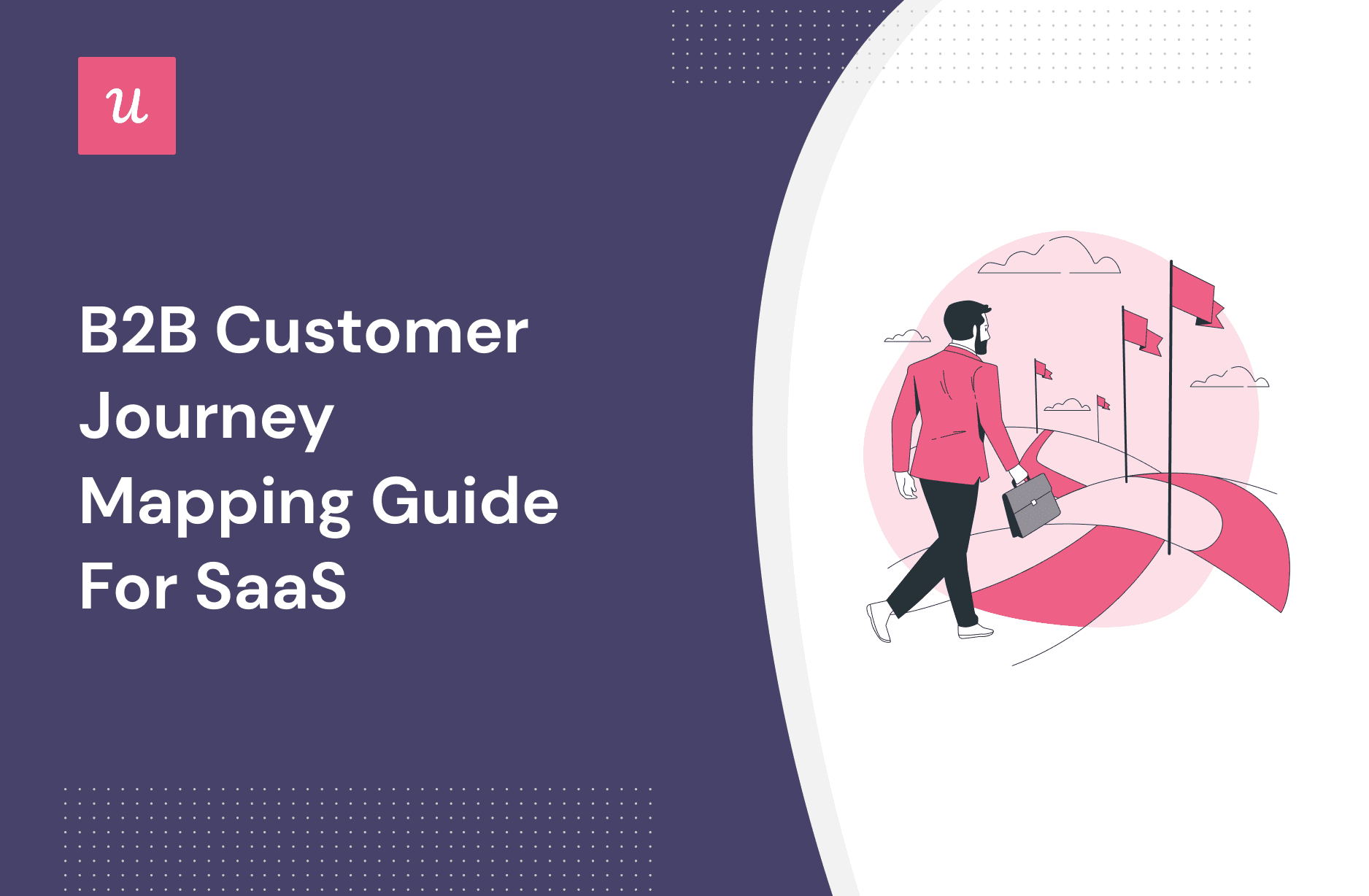
Interested in building a B2B customer journey map?
It’s a challenging process, but the benefits are well worth it. At the very least, a journey map will help you easily analyze and make data-driven decisions to improve the user experience. It also helps align your teams by ensuring everyone is on the same page regarding customer interactions.
In this article, we’ll cover B2B customer journey stages, how to build a B2B customer journey map, and the right tools to use.
- A journey map is a visual representation outlining the entire customer experience from discovery to conversion and beyond.
- Customer journey mapping informs customer experience management and helps you predict and meet user expectations, driving customer success and growth for your business.
B2B customer journeys are usually not a linear process, but here’s a list of the stages involved:
- Consideration
How to build a B2B customer journey map:
1. Understand your buyer personas and user personas:
- Collect feedback from existing customers
- Use signup surveys to get new customer information
Look at user behavior in-app to spot trends
2. Define important customer touchpoints for each user persona:
Look at acquisition metrics to understand important channels
Use heatmaps and website session recordings to understand the buying process, map your sales process touchpoints, define the activation point for different personas, understand the happy paths for different personas.
3. Measure and analyze how users progress through the customer journey
- Use funnel analysis to understand friction and drop-offs in the customer’s journey
- Collect customer experience feedback to know where you need to help users progress through the journey
- Iterate on your customer experience management strategy based on the information gathered
Best customer journey mapping and analysis tools to increase customer retention: Userpilot and Miro.
What is a customer journey map?
A customer journey map is a visual representation outlining the entire experience a customer goes through when interacting with your product, from discovery to conversion and beyond.
A detailed journey map will help you understand customer needs and pain points at every stage of their journey, equipping you to deliver positive experiences.
Why do you need a B2B customer journey map?
Journey maps inform customer experience management . By knowing the steps customers are expected to take at each key milestone, you can easily detect when they’re stuck and deploy means to remove friction . This will help you create a positive customer experience and boost customer retention.
Additionally, journey maps help you deliver more value by prompting account upgrades at the right stages. You’ll meet customer expectations and boost revenue.
B2B customer journey stages
The B2B customer journey is usually not linear but a complex and dynamic process influenced by various factors and multiple decision-makers.
After some research, Gartner found that B2B buyers move back and forth between key buying actions. Here’s what it looks like:

To illustrate, imagine a company identifies a need to improve its customer support process.
While exploring solutions, they realize upgrading their CRM software could help. So, they begin considering two options: get a higher tier from their current provider or find alternative software. While evaluating their choices, someone suggests implementing a chatbot solution might be a better fit.
This prompts them to revisit the problem and re-evaluate the solutions, factoring in budget and other considerations.
The above is just an example, but different shades of it happen in B2B companies all the time.
If the process is this complex, how do you win?
Your best bet is to provide decision-makers with information designed to help them move smoothly between buying stages.
To do that properly, you need to identify the key stages involved. We’ve outlined them below (still bear in mind it’s not a linear process):
- Awareness: Here, the customer understands their need and is searching for solutions. They conduct online research, ask peers, etc.
- Consideration: Customers in the consideration stage have identified potential tools or solutions that could solve their problem. They’re in the process of researching and evaluating different options.
- Evaluation: This stage involves the customer taking a concrete step to sign up for a free trial or create a free account. Customer activation happens here.
- Decision: The customer makes a buying decision, either opting for a paid subscription or becoming an active user of the freemium version.
- Adoption: After users have decided to use your tool, it’s time you make them see they made the right choice. Focus on helping this user group experience repeated value quickly, making them want to continue using your platform. Data-driven in-app onboarding is critical here. Collect customer data, tailor the onboarding to their needs, and keep analyzing to spot drop-offs.
- Expansion: This stage is where users upgrade to do more with your tool. It can happen multiple times in the user journey.
- Loyalty: At this stage, the customer is a happy and satisfied user. They continue to renew their subscription, are actively engaged with the product, and may even become brand advocates .
How to build a B2B customer journey map
So, how do you build a journey map that helps you convert customers, find user experience improvement areas, and boost customer retention?
Here are practical steps:
Understand your buyer personas and user personas
The buyer isn’t always the end user, especially in large enterprises. Buyers simply purchase the product and hand it over to end users.
For example, sales management might select SaaS tools for sales forecasting, CRM, or lead management. Their main objective when buying is to assess the tool’s impact on the sales team’s productivity and revenue generation.
On the other hand, the users will be sales reps, and their primary concern is usability and how the tool helps them meet sales goals.
Similarly, in large marketing teams, the head of marketing is responsible for buying marketing tools , but the people who actually use them are content creators, designers, social media managers, etc.
So, don’t confuse buyers for users when creating your personas . Unless you’re selling to startups, focus on developing two different personas for buyers and users.
Your personas should include multiple data points covering demographic information, behavioral data, pain points, goals, and preferences.
Wondering how to get this data? These three steps will help:
Collect customer feedback data to shape personas
Use customer satisfaction surveys to learn what brings positive customer experiences and what problems your product helps users solve.
This will enable you to understand who your best-fit users are. Once you have the survey responses, identify recurring feedback and use that to build your user persona.
Use your signup flow for data collection and define customer segments
Your signup flow is a good opportunity to learn about users from the horse’s mouth.
Keep it short, but ask questions that let you understand the main JTBD or pain points of users. You also want to ask questions that let you know how big the user is.
Here’s an example from Notion:

Dig into your analytics to understand the features your active users engage with the most.
This enables you to determine what’s valuable to different user segments.

Also, it aims to understand trends that lead to high customer lifetime value and use all the information gathered to create user personas that are not solely based on hypothetical characteristics but rooted in real user actions and preferences.

Define important customer touchpoints for each user persona
After following the steps above, you’ll have different user personas. Your next step is to define the critical touchpoints for these user groups based on their pain points.
Consider two factors: the number of traffic a channel generates and the quality of leads (in terms of ROI).
By identifying your top-performing channels, you can know where your ideal customers come from and incorporate those channels into your customer journey map.
You know the channels that bring in visitors, but how do these people behave when they land on your website and landing pages?
Use heatmaps and session recordings to find out.
Heatmaps offer a visual representation of where users click, move their cursors, or spend the most time on your web pages.
Session recordings, on the other hand, capture individual user sessions, allowing you to replay and analyze exactly how users navigate your site. You can see their cursor movements, clicks, scrolls, and interactions in real time.
Combining these two will give you an overview of the purchase process.
The touchpoints here will differ depending on whether you’re a sales-led or product-led company.
Touchpoints in a sales-led approach
- Initial outbound contact from sales reps
- Discovery calls
- Product demos
- Customized proposals
- Contract signing
For product-led companies, the touchpoints start with the product, and users progress independently with little to zero contact with a human agent. The typical touchpoints:
- Self-signup
- Account upgrades (trial to premium )
- Upsell /cross-sells
Activation is the point in the customer journey where the user experiences value. This varies for each product and can also be different for each user persona.
For example, imagine an email marketing tool used by a SaaS company and an e-commerce shop.
Ecom operators are mostly interested in recovering potential sales through abandoned cart emails. So activation for the e-commerce shop happens when they’re able to successfully trigger such emails.
For the SaaS company, they may be more interested in segmentation based on user behavior. For example, sending an email when a user completes a specific task.

The happy path refers to the ideal sequence of actions a user takes to achieve their goals with your product.
Map the ideal customer journey map for each step users need to take after activation. Highlight the features they need to discover and how often they should use them to adopt and become active users.

Measure and analyze how users progress through the customer journey
Collecting and analyzing user data helps you understand what’s happening at each stage. With the insights gathered, you’ll refine your B2B customer journey map and improve the user experience.
Here’s how:
Use funnel customer journey analysis
Use a tool like Userpilot to conduct funnel analysis and identify friction points and drop-offs in the user journey.
To gain deeper insights, pair this analysis with session recordings.
The combination will help you better understand user behavior and make informed improvements.

Collect customer experience feedback
Trigger CES surveys to gauge how easy or challenging users find specific aspects of their journey.
This feedback can uncover pain points or areas where users struggle. For example, you’ll know when they’re finding it hard to adopt a new feature, upgrade their account, comprehend your pricing structure, etc.
By pinpointing these specific issues, you’ll have a clearer roadmap for helping users progress smoothly through their journey.

Iterate on your customer experience management strategy
It’s not enough to collect qualitative and quantitative data; implement the insights to improve the customer experience.
- Trigger in-app flows to guide users across the journey where they need help.
- Adjust the customer journey map based on how your product evolves or the user needs change.
- Use in-app messaging to guide users to discover and adopt important features that will bring value to them.
For example, Rocketbots uses interactive walkthroughs to guide users through using and adopting key features :

Best customer journey mapping and analysis tools to increase customer retention
The right tool makes it easy to create a detailed B2B customer journey. While there are several products on the market, it can be hard to pick the one with the functionalities you need.
You can’t go wrong with Userpilot and/or Miro (depending on your needs).
Userpilot – for data collection
Userpilot is a product growth tool that bundles analytics , feedback , and engagement .
You can use it to collect data through in-app usage analytics and customer feedback surveys. Our platform also lets you analyze this data to spot trends and friction in the user journey.
Userpilot has features to let you trigger contextual in-app experiences to smoothen the customer journey.
For example, you could trigger an interactive walkthrough to guide users through using a feature they’re struggling with.

Miro – for visualizing the customer journey map
Miro is a collaborative online whiteboarding platform that greatly facilitates the visualization of B2B customer journey maps.
With its intuitive interface and extensive toolkit, Miro can enable your team to create, share, and collaborate on journey maps in a dynamic and visual manner.
You can easily map out each stage of the customer journey, incorporating elements like personas, touchpoints, pain points, and key interactions. Its real-time collaboration features allow you to work together seamlessly, whether you’re in the same room or distributed across the globe.
Is having a B2B customer journey map an absolute requirement for success?
Definitely not. You can thrive without one. However, journey maps help you become more customer-centric and deliver better user experiences. That’s what savvy SaaS customers want, and it will unlock growth opportunities and boost your customer retention rate, loyalty, and revenue.
To get started, book a demo call with our team and see how Userpilot helps SaaS companies create detailed B2B customer journey maps.
Leave a comment Cancel reply
Save my name, email, and website in this browser for the next time I comment.

Get The Insights!
The fastest way to learn about Product Growth,Management & Trends.
The coolest way to learn about Product Growth, Management & Trends. Delivered fresh to your inbox, weekly.
The fastest way to learn about Product Growth, Management & Trends.
You might also be interested in ...
Contact | Sign In | Blog
The Modern B2B Customer Journey
I was recently asked to map PartnerTap’s capabilities to the B2B customer journey. When I got off the phone, I realized I should have asked “Which one? The old B2B customer journey or the modern one?”
For the past 20 years the customer journey has started with a Google search

I’ve been a business buyer of technology solutions. And I’ve spent way too many hours reading through marketing content for all the solutions that come up on the first 2 – 3 pages of Google’s search results. I did this research to identify the initial list of solutions and companies I should evaluate. I’d then set up calls with each vendor, have too-many-to-count conversations with sales reps, eventually see the product demos, and narrow down the list of solutions to socialize with other internal stakeholders.
The modern B2B customer buying journey starts with your partners
Every buyer out there is already working with someone else. They’ve worked with other technology vendors, other consultants, purchased some solutions through resellers, and already have a myriad of solutions they use in house.
If you’re lucky, your company is already partnering with many of these companies.

The modern buyer has already built relationships with some of your partners, and already have people they trust as experts. This means your buyer doesn’t have to start a new buying process with a Google search. Instead, they can cut through the noise and quickly get to a short list of products they should consider and companies with good reputations by asking your partners .
The modern buyer is cutting through the noise and turning to people they trust for product and vendor advice

The modern B2B buying journey includes partners at every step of the process
The end-to-end buying journey starts with evaluating what they already have and thinking through how a new solution will be adopted within the current set of solutions. Your partners are most likely aware of and influencing your buyer’s purchase decision before you even know there’s an opportunity.
5-step summary of new B2B buying journey:
- Clarify their needs, context, and current gaps. Buyers recognize that anything new they buy must work with their current solutions – many of which are from your partners.
- Identify the best options by asking experts they trust for recommendations. This includes the consultants and vendors they already work with and trust. Many of these are your existing partners.
- Evaluate and validate that solutions will work in their environment with product specialists. Modern buyers put less stock in what sales reps say and more value in what trusted partners say.
- Purchase new solutions through existing suppliers, marketplaces, or direct from a new vendor. Buyers may prefer to purchase through an existing supplier or service partner who will ultimately be responsible for their long-term success.
- Adopt the new solutions leveraging expertise and support from the SIs, VARs, MSPs, etc. who support them .

There’s no easy way for partners to share details about your buyers
Buyers ask your partners for advice about which solutions to look at – these are the exact moments that your sales team needs to know about. But there’s no easy way for your partners to reach the sales rep on this account to share this valuable intelligence.

The BEST INTENTIONED partners will try to do their best to try to get this timely information to your reps, but the slow-motion game of telephone rarely makes it to the stage where your seller and the partner get on the phone and brainstorm the best way to get your solution into this account.
The reason it’s so hard is CRM systems were never designed to let reps collaborate with sellers outside of your company. CRM systems are incredibly secure – as they should be!
There’s a big gap in today’s B2B sales stack

But supporting the modern B2B buyer journey requires that sales reps find and collaborate with the sales reps already engaged at their accounts.
So account executives try their hardest. They get on the phone with partners to see if they have any shared accounts. They email around lists of target accounts to try to find partners that already have relationships there. And they spend hours manually scanning through customer spreadsheets trying to find any matches between their territory and each partner.
Your sales reps don’t know which partners to work with on each account

Sales reps do everything they can with the systems they currently have – which means they email around a lot of account lists in Excel. But this doesn’t scale, and it misses a lot of expansion and new logo opportunities your sales teams could be going after with each partner.
The current manual approach to co-selling can’t scale

We call this valiant effort “Random Acts of Co-Selling”, and since we’ve already written a lot about it, I won’t repeat it here. Read: Go Beyond Random Acts of Co-Selling
Most sales reps today do “Random Acts of Co-Sell”

Co-selling transformation is key to faster growth and aligns perfectly with the modern B2B buyer journey.
Supporting the modern B2B buyer with a co-selling motion requires an account-centric approach. An account-centric, or buyer-centric, approach requires that you first have:
- An ecosystem-wide view of all partners engaged at each account
- Real-time alignment of your sales reps with partners also engaged at each account
- An easy way to activate your sales reps and partners around high-propensity-to-buy accounts so they can quickly get on the phone for a pre-opportunity brainstorming conversation
- Attribution and reporting to make sure you can track all the new pipeline sourced and accelerated with each partner and each co-sell sales play
Supporting the modern buyer requires an account-centric approach

The reason so many vendors are coming to us this year is because co-selling transformation is now an imperative . My CEO just got off stage talking about co-selling at Channel Partners Expo in Las Vegas and she texted to say she can’t call me back because she’s being approached by so many vendors who are ready to go now because this is so important for their new GTM strategy.
For anyone reading this that doesn’t already know I’m the Chief Product Officer at PartnerTap, and love everything about our market, our customers, and our product, here’s a quick overview of what PartnerTap’s co-selling software does:

Scaling up a high-performing co-selling motion with your best partners requires the right expertise, data, and automation. That’s why I’m so happy that this year we are offering Co-Sell Concierge Services along with our enterprise-leading co-selling software to help our customers jumpstart their co-sell programs and show new sourced pipeline within the first quarter.
Co-selling expertise is required to support the modern B2B buyer journey
When our customers keep their customers and buyers’ success as their north star we all win. That’s why I love working with customer-centric organizations who just need to expand the radius around their customers to include all their best partners already engaged with each account.

But it starts with the partner ecosystem data. Once a change agent is committed to co-selling transformation, the first thing they need is some detailed partner data and real-life examples and results around which to model the full-scale strategy and program.
That’s why we always recommend a crawl → walk→ run strategy for co-selling transformation.

Looking forward to talking with all the co-sell eager vendors from Channel Partners Expo in the next few weeks!
Recent Posts
- New Ecosystem Role: Co-Sell Quarterback
- Shifting Vendor and Partner Power Dynamics in Co-Selling
- Five New Co-Selling Leadership Opportunities
- February 2024
- January 2024
- December 2023
- October 2023
- September 2023
- August 2023
- February 2023
- October 2022
- February 2022
- January 2022
- November 2021
- October 2021
- September 2021
- August 2021
- February 2021
- January 2021
- December 2020
- November 2020
- October 2020
- September 2020
- November 2019
- February 2018
- December 2017
- January 2017
- December 2016
Ready to scale-up co-selling and grow faster?
Invited by a partner.
You can use PartnerTap for free – forever.
Create FREE Account
What do B2B Customer Journeys Look Like in 2024?
We walk through how B2B businesses should approach constructing the ideal customer journey in 2024.
What is a B2B customer journey?
The 5 stages of the b2b customer journey, b2b vs. b2c customer journey mapping, how b2b customer journeys are evolving in 2024, 3 challenges of b2b customer journey mapping, how segment can supercharge your b2b customer journeys.
A B2B customer journey refers to all the interactions that take place between a business and a customer as the latter moves through the funnel. But in a B2B context, the customer in question is usually acting on behalf of their organization (e.g., a team of stakeholders looking to bring in a new email automation tool into their MarTech stack) .
As a result, B2B customer journeys are usually much longer than business-to-customer (B2C) interactions – sometimes culminating in months-long exchanges that require input from multiple decision-makers.
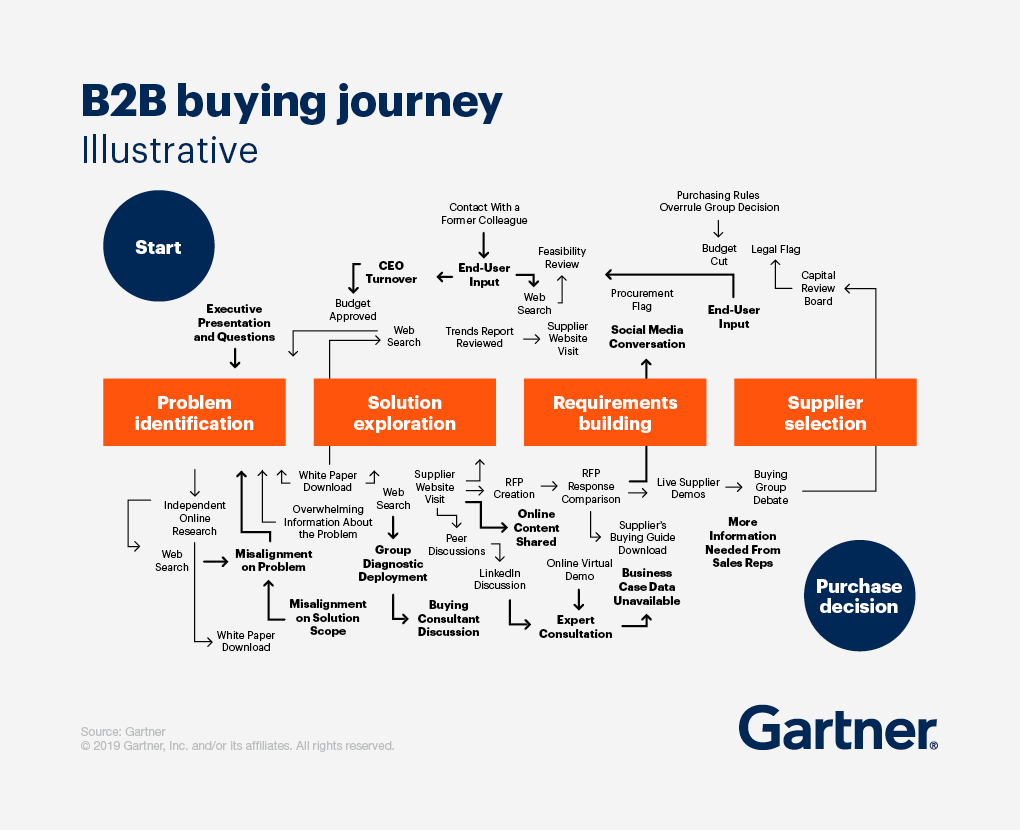
The customer journey describes all the interactions that take place between a customer and a business. It starts before a customer discovers your product and continues beyond the point of sale.
While they’re are key distinctions, both (B2B) and (B2C) customer journeys share the same five basic stages:
Awareness
This is when a customer becomes aware of a specific pain point or need they have, and starts searching for a solution. From a business perspective, this is where having a sharp understanding of your audience and target personas comes into play. When driving brand awareness, you’ll often cater your messaging to speak to each individual and relevant persona. For instance, if you’re marketing a live chat tool, when advertising to a potential end user you’d likely showcase specific features and its ease of use. But when promoting it to someone in upper management, you may focus on the ROI their business stands to gain.
One way to capture your target audience’s attention is to run ads based on lookalike audiences – here’s how .
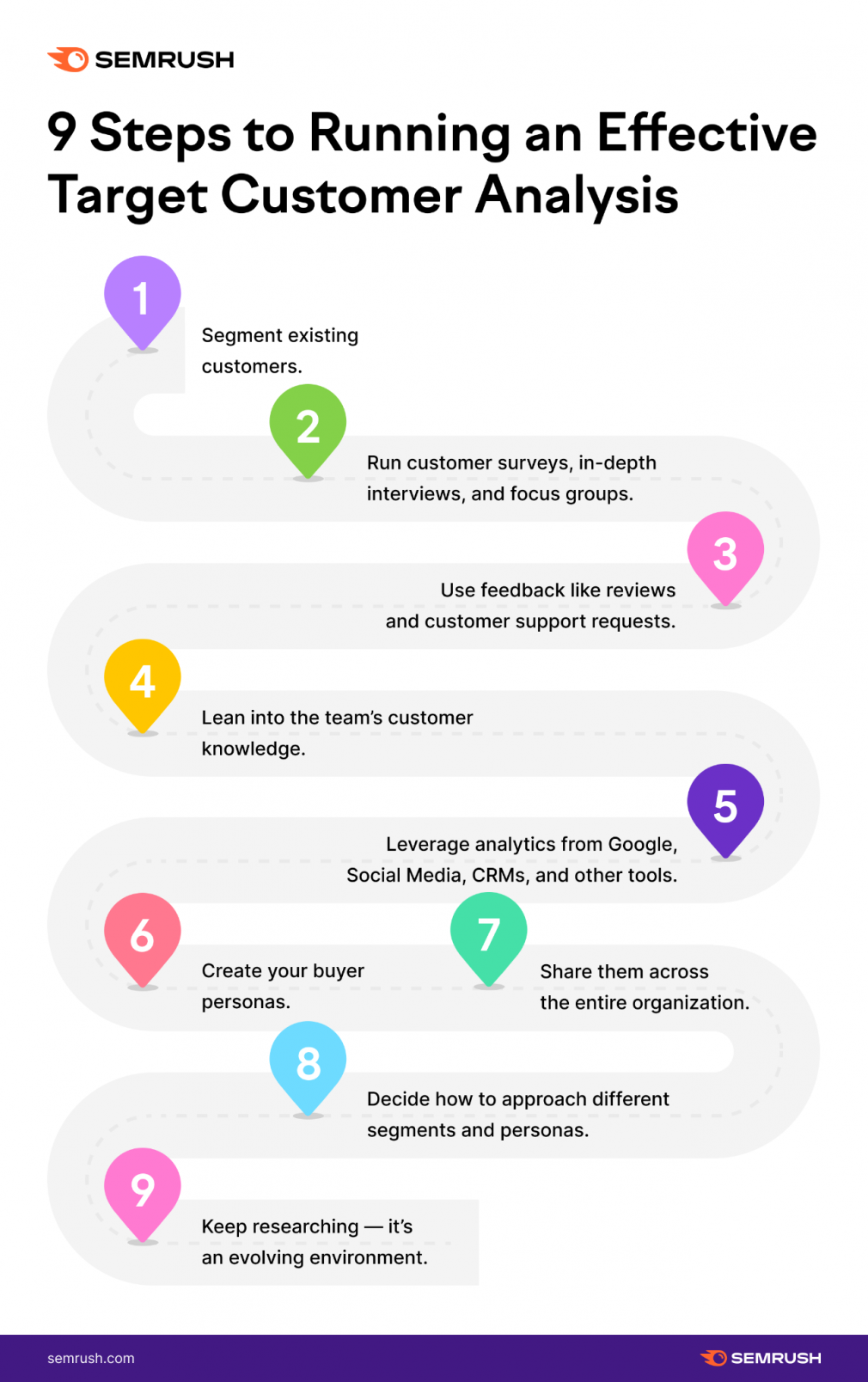
Consideration
The consideration stage is when a prospect discovers your product or service as a potential solution to their problem. This can look like: browsing relevant product pages on your site, requesting a demo, speaking with live chat bot – a sort of fact-finding mission to understand how your product stacks up to their expectations (and why it’s better than your competitors). As we said earlier, in a B2B setting this process can take a long time due to the multiple stakeholders involved in making a decision.
The conversion is the point when the customer makes a decision to commit to your brand, perhaps by signing up for an account or committing to a premium subscription (whatever your ultimate conversion goal happens to be).
Conversion is not the end of the road, though. Once a customer starts using your product or service, a new facet of the customer journey begins: one that’s concerned with helping them reach time-to-value as quickly as possible and preventing churn. This is where personalized onboarding flows can come into play, and when onboarding journey maps can be especially useful to have a solid idea of what milestones your customers should be hitting and when.
5 Tried-and-True Onboarding Campaigns + Templates
This step-by-step guide describes how to implement 5 user onboarding campaigns to drive long-term loyalty..
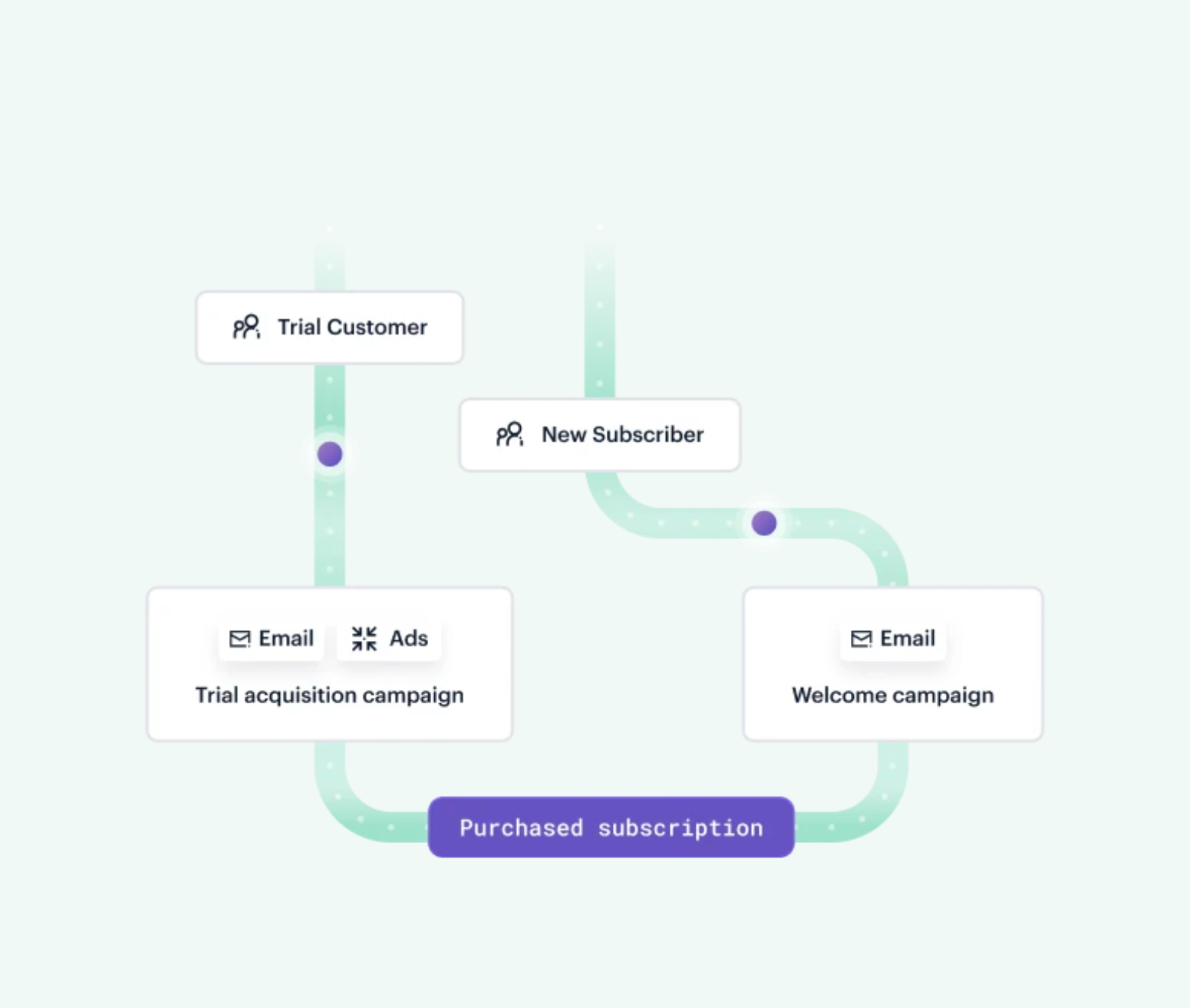
We use your information according to our Privacy Policy . You can update your preferences at any time.
For example, at Twilio Segment we know that setting up a Source and Destination, and having data flow between these two points, is a crucial step for users to recognize product value. By analyzing the behavior of both retained and churned customers, we were able to pinpoint when, approximately, a customer should have completed this step – and proactively intervene if they seemed to be struggling.
You can learn more about how we used data to streamline onboarding here .
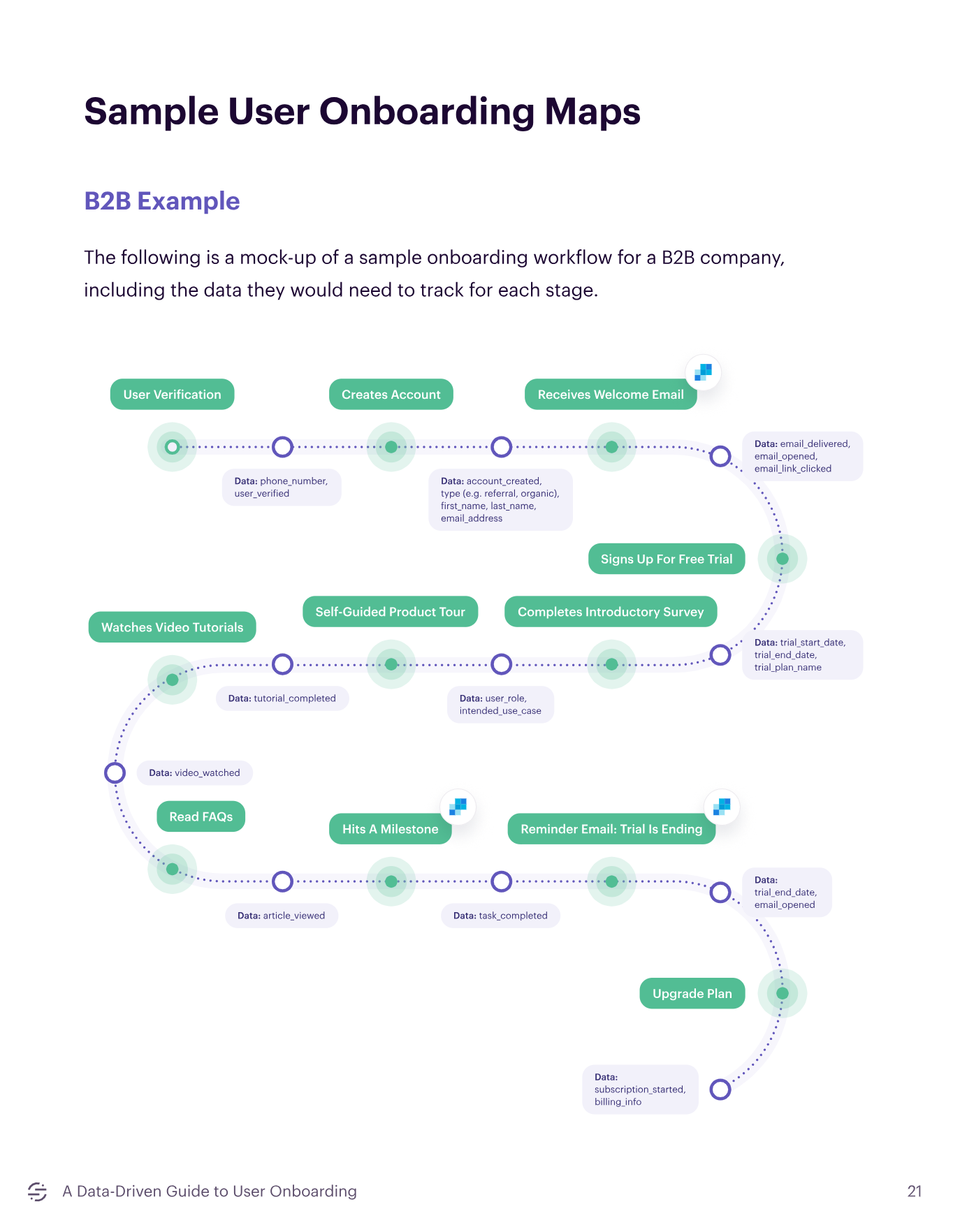
An overarching goal is to have your customers become staunch supporters of your product – not only so they remain customers, but so that they also become brand advocates.
Referrals are an incredibly powerful and cost-effective way to acquire new customers. And with the right data, you can pinpoint the most strategic time to ask customers to give a referral and even automate your referral program.
Customer journey maps are “documents that visually illustrate customers’ processes, needs, and perceptions throughout their relationships with a company,” according to Forrester Research . They identify interactions and touchpoints at every stage of the customer lifecycle.
You create these maps to understand how customers view the experience of doing business with your company – meaning you take their perspective. That’s why Forrester also calls these documents “moment of truth” maps.
There are some differences between B2B and B2C journey mapping, however, mainly: the number of touchpoints, and the number of decision-makers and stakeholders involved.
Touchpoints
Customer journey touchpoints take place before, during, and after a sale. As B2B sales cycles tend to be longer than B2C ones, B2B customer journey maps have more touchpoints in the awareness and consideration stages.
Certain touchpoints are particularly important in B2B relationships – think reading case studies and customer testimonials, viewing product demos, comparing prices and product features, going through week 1 onboarding, and evaluating a plan upgrade.
Decision-makers
With B2B marketing, you have to convince multiple stakeholders of your product’s value since the end-user may not be the same person with the purchasing power. You need to understand these individual personas, and engage them on the channels they prefer .
By contrast, in B2C marketing, the consumer and end-user are usually one and the same person. (Family products tend to be an exception – for example, you’d market baby products to parents, not the babies themselves.)
B2B customer journeys are becoming more complex, as more business users now expect a customer experience similar to that of B2C brands. This demand is largely driven by millennials, who are now the primary B2B decision-makers, according to research by The B2B Institute and LinkedIn .
Being digital natives, millennials are used to cloud-based software and collaboration tools, and the experience of using these services has shaped their expectations of B2B products and solutions. For instance, they demand self-service sales transactions – choose a plan, pay for it, set up an account, and go. Gartner found that 44% of millennials don’t want to interact with a sales rep when it comes to making B2B purchases.
The report notes that millennials “are being met with a wave of new digital products, brand concepts, AI-powered plug-ins and productivity tools that are more akin to the consumer user experience of Uber and Airbnb than traditional business services.” To deliver similar experiences, B2B brands like Basecamp, Stripe, and Slack have mimicked popular lifestyle apps with their high-gloss marketing campaigns, aesthetics, and emphasis on UX.
The post-sale experience is changing, too. With the rise of “everything-as-a-service” models like SaaS, businesses need to convince customers to renew their subscriptions either monthly or annually. It’s now crucial to repeatedly engage customers at the service and loyalty stages through customer retention and engagement strategies.
Plotting out the B2B customer journey is a crucial step in empathizing with your prospects (and hopefully streamlining the path to conversion). However, B2B customer journey mapping is not without its challenges. As we mentioned above, these interactions can be complex, lengthy, and span numerous touchpoints. The point being: there is rarely a linear path between awareness, conversion, and retention when it comes to B2B customer journeys.
Below, we talk about these challenges (and how to overcome them) in more detail.
Identifying & prioritizing potential customer touchpoints
For a long time, marketers have turned to third-party cookies to help them with ad attribution and retargeting prospects. But in the past few years, data privacy regulations and browser-led changes on iOS, Safari, Firefox, and Chrome have been leading to one thing: the end of third-party cookies .
However, many companies haven’t completely broken up with third-party cookies yet – meaning they may be ill-equipped to understand the customer journey in its entirety if they don’t implement a new strategy.
So, what’s the way forward? In short, a prioritization of first-party data . This type of data, which businesses gather from direct interactions with their customers, is compliant and serves as a competitive differentiator (that is, no other business has access to those insights). But for first-party data to be effective, it has to be consolidated – or in other words, there shouldn’t be any blindspots between teams when it comes to customer interactions.
Integrating the customer experience across touchpoints
One goal of customer journey mapping is to create a consistent experience across channels and touchpoints. But as the number and variety of those touchpoints grow, integrating tools can be complicated.
For instance, different tools might use different naming conventions for data collection . You’d have to standardize these names if you want to unify data from multiple sources. To create this unified view, there are a couple steps you need to take:
Create a universal tracking plan for your business that clarifies the proper naming conventions for data, what’s being tracked (and why), and where that data originates from and ends up.
Ensure this data is consolidated into a central repository and that data is democratized across teams (e.g, marketing teams don’t need to depend on analysts or engineering to pull audience lists – they can do it themselves, in real time).
Preventing data silos & ensuring all teams can access customer data
The lack of integration between tools results in data silos and missed opportunities to engage customers. Let’s say sales has given a product demo to a specific prospect. If marketing doesn’t know that, they might email the prospect an invitation to try a demo. As a result, you waste the customer’s time (and your own), along with inviting their annoyance.
What are the hallmarks of an effective B2B customer journey? As we’ve explored in this article, there are a few healthy indicators: an emphasis on first-party data, a democratization of data across teams, unified, real-time customer profiles .
With consumers gravitating to multi-channel interactions, it’s become imperative for businesses to fix any blindspots that may crop up in their strategy. Effective marketing and top-tier customer experiences are now built on data, and having a scalable infrastructure in place is fundamental.
Enter, the customer data platform. CDPs have emerged as a must for businesses, helping to collect, clean and consolidate data in real time and integrate every tool and app in their tech stack. Here’s how a CDP like Segment can supercharge B2B customer journeys.
Centralize & consolidate your data
Segment’s CDP can consolidate data from every customer touchpoint , ensure it’s cleaned and validated, and then send it to any downstream destination (like email, advertising, customer service, or product development software) for activation.
A common challenge for businesses is being able to consolidate and trust the data they collect to glean insights. Too often, data silos pop up due to disconnected tech stacks, resulting in blind spots across teams. This can wreak havoc on the customer experience and business operations.
Say a customer has an issue and tries to resolve it via live chat – providing details about their account, the problem at hand, and so forth. They end up being transferred to a phone call with a representative…and have to repeat everything they just went over. Not ideal.
With consolidated, trustworthy, and accurate data, businesses can have more precision in their customer interactions, creating a better overall experience that pays dividends when it comes to greater customer satisfaction and retention rates.
Create a single customer view
Identity resolution is the process of stitching together a customer’s behavior, from across channels, into a single, unified profile. This single view of the customer is essential for effectively engaging them – giving every team a 360-degree view of how they’ve been interacting with your business. It’s a crucial component of creating a cohesive customer journey, especially when these profiles are updated in real time .
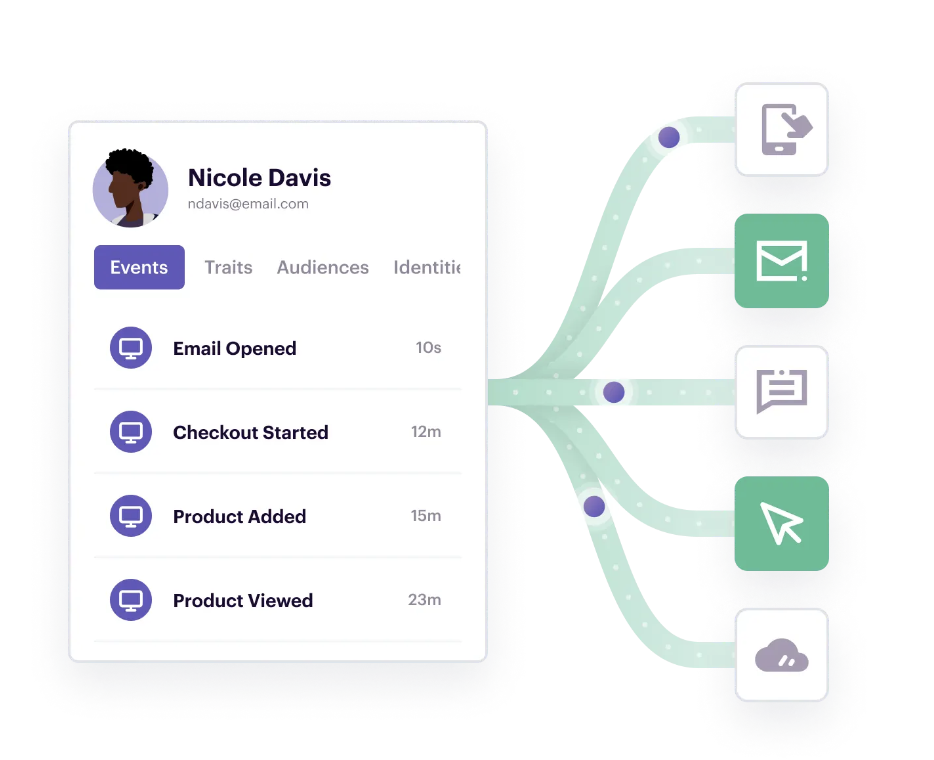
Personalize campaigns with real-time data
With this complete, overarching view of customer behavior, businesses can then leverage real-time data to personalize experiences at scale . For instance, with Segment Journeys , teams are able to orchestrate multi-step, and multi-channel campaigns based on a person’s actions in the moment .
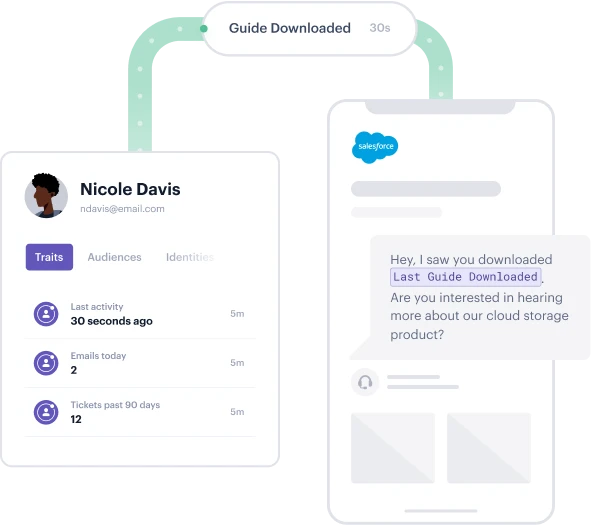
Interested in hearing more about how Segment can help you?
Connect with a Segment expert who can share more about what Segment can do for you.
Frequently asked questions
What are the stages in the b2b customer journey, what are the benefits of creating a b2b customer journey map, what are examples of customer touchpoints, how are b2b and b2c journeys different, how can twilio segment help b2b companies construct customer journey maps.
- Skip to primary navigation
- Skip to main content
- Skip to primary sidebar
- Skip to footer
Demand Gen: Growth Unleashed.
The B2B Customer Journey: What It Is and Why You Should Care
Ron Sela / Last updated: January 14, 2022
The B2B customer journey is one of the best tools you can use to understand your customers. A good customer journey map will help you understand your customers and the thought processes they face when buying your product, from pain points and bottlenecks where they leave to good interactions and services that keep them coming back.
Understanding your customer’s journey from when they first become aware they have a problem to post-product satisfaction will help you optimize your processes to create satisfied customers who advocate for you.
A good customer journey map can be the difference between business growth and a high customer churn rate . B2B customer journeys are more complex than B2C customer journeys, making mapping their journey all the more important for your business.
Table of Contents
Key Takeaways
- A B2B customer journey map visually illustrates the entire process a customer undergoes before, during, and after purchasing a product, highlighting key pain points and opportunities for process optimization to enhance customer experience.
- The complexity of B2B customer journeys, involving multiple decision-makers and a longer decision-making process compared to B2C, underscores the importance of mapping these journeys to effectively cater to both buyers and users, ultimately facilitating business growth and reducing customer churn.
- Creating a B2B customer journey map involves identifying and understanding the seven key stages (awareness, consideration, conversion, delivery, support, loyalty, and advocacy) and using customer feedback and data analytics to refine business processes and improve overall customer satisfaction.
What is a B2B Customer Journey Map?
A B2B customer journey map is a visual representation that shows all the processes your customer goes through before, during, and after buying your product.
The customer journey should include pain points and bottlenecks where your customers may decide to go to one of your competitors. However, the most essential function of a customer journey map is to show you how to optimize your processes and decrease those pain points, creating a more positive customer experience .
Why B2B Customer Journeys Are So Important
The B2B customer journey is far more complicated than B2C customer journeys. That’s because in B2B journeys there’s more than one buyer, and the buyers might not be the same as the users.
The buyers are usually the senior management while the users are typically lower-level employees. This matters because you’ll have to find a way to market and appeal to both of them. Knowing what each segment wants will help you market and support them more efficiently.
Moreover, it takes far longer for businesses to come to a decision on whether to buy your product or service. Months longer than the typical B2C customer, and they typically perform a lot more research than B2C customers as well. Ultimately, B2B customer journeys are longer, more complex, and as a result, much harder to chart accurately.
A customer journey map can show you where they feel like they should drop you, where they need more support, and in general help, you see where you need to focus your resources to keep more customers and make sure they’re happy.
Why Does Customer Journey Mapping Work?
You probably already have a good idea of what your customers are thinking, right? Wrong. You feel that you know what your customers think when they buy your product. Your company’s internal perspective on what customers think and feel is often wrong.
The reason journey mapping works is because it is data-based. Data gathered from customers who’ve enjoyed your product and are happy and those who decided to drop you for something else.
Those who dropped you are especially vital as they indicate processes you can improve that could keep future customers like them.
What Makes B2B Different From B2C?
They both start with a problem, seek a solution, and either end up satisfied or go somewhere else. That’s where the similarities end.
In B2B transactions, there are frequently many decision-makers in the business that decide whether to go with your product.
The B2B customer journey includes many different people, from the buyers to the users, to the buyer-users, and they all have different pain points, needs, and experiences.
Trying to map all this out can be complicated, but the result is worth it. A good B2B customer journey map will give you a comprehensive view of your buyers and how you can optimize your business processes for them.
How a B2B Customer Journey Map Can Benefit You
Now that you know what it is, why do you need one? Well, understanding your consumer is vital for any business. Visual representation of how customers move through your company processes is invaluable for marketing and sales . They’ll know how to target the customer and when.
This understanding is also valuable for fulfilling your customer’s needs and supporting them. It lets you know what to expect when your customers contact you for support, how you can make complicated processes such as delivery and conversion easier for them, and just in general, improve your customer’s journey with your business.
Benefits of a B2B Customer Journey Map
● create a high-level view of the customer journey, ● establish buy-in on the senior level, ● help employees understand the customer’s view and needs, ● increase employee engagement, ● curate a better customer experience, ● increase advocacy of your brand, ● better results in generating and acquiring leads, ● lower churn rates, ● boost customer retention, increasing lifetime value, ● all-around business growth, how can i create my own b2b customer journey map.
All customer journeys have seven steps, awareness, consideration, conversion, delivery, support, loyalty, and advocacy.
1. Awareness
The first step in the customer journey is awareness. Being aware of your customer’s needs will help you with this. The beginning of the journey is when customers realize they have a problem and actively seek out a solution. The best thing you can do for this step is to rank high on search rankings so customers can find you swiftly and efficiently.
2. Consideration
Consideration is when the customer researches your product and service and compares them to your competitors.
Having readily available materials is vital for this step, such as white papers, demos, videos, and other readily available online research materials. This step in the customer journey is crucial for the next step.
3. Conversion
Conversion is everyone’s favorite step in the customer journey. The customer researched all their available options and decided you were the best. They’ve contacted you and are ready to pay up and buy your service.
The buying experience is vital to customer satisfaction, and having good business practices for their purchase is essential. The buying process should be painless and easy for the customer.
4. Delivery
Delivery may be the most critical step in the B2B customer journey. Your company has to fulfill all of the promises made during the previous stages. Delivery of the product should be fully supported and easy for the customer.
5. Support
Business success comes from customer success, so you should do everything you can to make sure they succeed. While delivery may be critical, so is this.
You need to continue supporting your customer, answering questions about the product, helping with issues that arise, and supporting the customer in all aspects of your product. Nurturing current customers is the best way to ensure you get new ones.
6. Loyalty
Positive customer experience and support for the product or service you’ve given will lead to customer loyalty and trust in you and your product.
They’ll be more likely to keep you in the future, boosting customer lifecycle value, especially for companies that offer services such as SaaS companies.
7. Advocacy
The best B2B advertisements are words straight from the consumer’s mouth. Good brand experience will lead to testimonials and glowing reviews, bringing in more customers, starting the process anew.
This last step in the customer journey helps you get more customers to feed into the process again, creating a never-ending loop of success for you.
Data, Data, Data
You need to get customer feedback from every step in the process, from your customers, from people who went to another company, from people who dropped you, from everywhere customers contact your company.
Customer feedback data is what drives your customer journey maps. That said, you don’t need to gather everything solely from customers.
It might be helpful to ask departments and people who regularly contact customers, such as sales teams, customer service representatives, and support departments. They all have regular contact with customers and are essential touchpoints in the customer journey.
Why Research Is Important
Market research is crucial to learn about your core customer segments, and compiling that data into a readable chart is a daunting task. However, the journey mapping exercise is key to understanding the buyer’s journey. In B2B journey mapping, you need to prove you’re worth your market share to the buyer and ensure they’re satisfied at all the journey stages.
Often the people buying the product and the people using the product are two completely different sets of people, so the buying journey is long and complicated.
That is why data analytics is so crucial for B2B customer journey mapping.
It gives you a clear view of how the customer moves and feels throughout their experience with your company. Customer journey analysis helps you see where customers fall through the cracks and how you can patch them.
Remember Data, Not Internal Perspectives
Remember, you should use data for your customer journey map, not your internal perception of the customer journey. B2B customer journey mapping relies heavily on data as it’s overly complex and can have many more customer touchpoints than B2C customer journey mapping.
A good customer journey map helps you identify where you can do better, while a bad one sits on a poster in your office. So gather data on as many different touchpoints as possible to optimize your business practices.
Customer Personas
Who is your ideal customer? Understanding your customer’s journey doesn’t mean much unless you know who’s walking it. That is why you should create personas . Personas are caricatures of your ideal customer, who they are, and what they need.
In B2B customer journey mapping, personas can get messy because there’s more than one buyer, and buyers and users may not be the same people, which is why you should include personas for all of them. Buyer personas, user personas, buyer-user personas.
Include their job title, company size, what they’re looking for in your product. The customer needs between buyers and users might differ, and their decision-making process focuses on different things.
Learn About Your Consumers
Buyers tend to focus on value, while users focus on your product’s integration and usability. So you need to create these personas and find different ways to target them. You should ensure you are getting through to your target audience and even create profiles for the ideal company you would like to work with, like what industry they should be in and how many employees they have.
You should have a good idea of whom you want to work with and check if your current clients match this profile. If they don’t, you may wish to change your marketing strategies to target the B2B customers you want.
Buyers tend to focus on the value you bring to the business. This includes high-level management and stakeholders in the company. They tend to be critical near the beginning of the journey stages but warm up to you once you prove your worth to them.
They’re focused on whether your product or service is worth the money to them. So make sure you’re providing plenty of value.
Unlike buyers, users are focused on the usability and versatility in your product. They want something that’s easy to learn and integrate into their workflow. They’re typically the ones doing the research to see if your product is a match for their needs, so give them plenty of materials that prove your support and versatility.
Managing Your Customer Experience
Positive customer experiences don’t just manifest out of thin air. You have to curate them. Journey mapping is one part of that. Once you understand how the customer moves through your processes, it’s time to update them.
Update all of your processes to give better customer experiences, whether that’s more frequent calls to check up on the customer, update your website with new research materials showing your company’s value, or even get a better delivery process and support system.
Everything should come back to the customer, and if you’re doing it right, you’ll see it reflected in an updated customer journey map.
You’re Not Done Yet
Mapping your customer’s journey is just one step in the process. Afterward, you need to identify critical touchpoints, identify pain points and relieve them, open up bottlenecks and confer with your department heads on how to improve processes to improve the customer journey.
Moreover, improvements don’t just end. You don’t finish your journey mapping and optimize your processes just once. You should repeat this process every year or two to make sure you’re on top of the ball for customer success and satisfaction.
Change the Way You Think About Customer Service and Customer Satisfaction
Finally, you need to change how you think about your customer experience management. The touchpoints you interact with stretch across your whole company, and even departments that don’t come into direct contact with customers can be improved to offer a better customer experience.
You can use everything from your sales qualification process to the purchase process and even your marketing efforts to enhance your customer relationship. Journey mapping is just one step of this process, along with personas and fulfilling your customer expectations.
Change the Way You Think About Customers and Watch Your Business Thrive
For example, sales reps familiar with personas can better target buyers and users to give more effective pitches. Having a B2B customer journey map your employees are familiar with increases employee engagement and helps senior management optimize their department’s practices to make the end-to-end experience perfect for customers.
Customer success and satisfaction also lead to better inbound lead generation and lead acquisition. When customers see testimonials or receive recommendations, they’re more likely to move to the purchase stage and buy your product or service.
High customer service and satisfaction also lead to repeat business, making it easier to acquire enterprises who’ve used you before. All of this leads to more business growth for you, so customer success is integral to your own goals.
Keep In Mind
Customer journey mapping isn’t easy, especially B2B customer journey mapping. But at the end of the day, you need to remember it’s about the customer experience. You want to manage the customer journey to create a better customer experience.
Here are some of the most common questions about the B2B customer journey
Awareness, consideration, conversion, delivery, support, loyalty, and advocacy are the seven steps every customer journey map needs to take in order to succeed.
The buyer persona, which is the fictional representation of the customers you are targeting. The pain points , which is the reason customers hesitate to buy or bottleneck the business. The customer’s emotional journey as well as their actions and thoughts and finally the touchpoints, which is where the business has some kind of contact with the customer.
First you have to identify what your business is all about, how it’s organized and how it makes decisions. Then you have to do the same, but in this case, for the customer. Once you have perfectly placed who is who, understand each one’s needs and desires. Finally, map the journey into phases.
Related Posts:
- The Complete Guide to the Customer Acquisition Funnel
- The Power of SEO Digital Marketing: Boost Your…
- Digital Content Strategy: How to Make the Most of…
- How to Develop an Accurate B2B Buyer Persona that Converts
- Full Funnel Marketing Strategy for Lead Generation
About Ron Sela
Ron is a marketing advisor to technology-driven businesses. He has 15 years of digital marketing experience and an MBA from the University of Florida. Ron helps companies grow their revenue by developing and executing integrated marketing plans that align with their business goals. He has a proven track record of success in helping companies achieve their growth objectives.

IMAGES
VIDEO
COMMENTS
The generally optimistic spending outlook of enterprises appears set to translate to solid growth for the tech and telecommunications B2B market this year. In total, we project an increase of roughly $150 billion, or about 8.5 percent, in the 15 geographies covered by the survey, reaching $1.9 trillion in annual revenue.
There are four key ingredients for successful customer-led CX transformation: End-to-end redesign of service delivery. New business insights enabled by data, analytics, and AI. Refined commercial model to capture new CX-generated value. Broad cultural transformation and investment in frontline CX capabilities. 1.
Our in-depth report, "The Future Of B2B Telco", navigates the intricate journey of telcos transitioning into tech orchestrators, seamlessly integrating connectivity, cloud solutions, cybersecurity, data, and applications. In an era marked by the commoditization of traditional connectivity, telcos face a pivotal crossroads.
We began conducting our cross-sector B2B Pulse survey annually in 2016, and the trend toward an omnichannel environment was quickly evident. The most recent B2B Pulse GTM tech and telecom survey was conducted in December 2022, gathering responses from more than 750 B2B customers and sellers in decision-making roles in Australia, Brazil, Chile, China, France, Germany, India, Italy, Japan, South ...
The Value of Customer Journey Mapping & Challenges in B2B Markets. Customer journey mapping is just one stage in the move towards a customer centric approach. It marks the starting point; placing the experience of the customer at the heart of what the company does and how it operates. It provides a single overview of how customers interact with ...
Here are the key reasons to design a B2B customer journey map: Enhanced customer understanding — A customer journey map provides valuable insights into the needs, motivations, pain points, and behaviours of your B2B customers. It helps you better understand their challenges, preferences, and decision-making processes.
In telecom, customer journey management is often hindered by the overwhelming variety of product combinations, support not being able to keep an omnichannel front, and people ready to jump ship for another provider at the slightest issue. ... B2B Customer Journey Empathy Map Employee Experience Events Impact Map Personas Research Templates ...
The B2B customer journey stages consist of five main areas: awareness, consideration, conversion, loyalty, and advocacy. The exact stages may be broken down further or vary depending on the specific type of business (for example, some companies may require onboarding, or have multiple points of purchase).
The 5G B2B customer experience must evolve. The BSS enabling enterprise offers need to support smooth, simple CX to successfully monetize new services. BSS must be able to support enterprise interactions and frictionless experiences with: Intuitive customer and partner engagement systems. Catalog-driven approaches and exposure of catalog to ...
The pandemic has certainly accelerated the consumerisation of the B2B space. It now has to be digital first. But it needs to be digital first in a way that the basic stuff is really seamless, the basics must work. Then you use human interactions to really augment the overall experience," says Katy Pearce, head of customer experience at ...
Revenues across the telecom industry's crucial B2B segment are slowly declining. The needs and desires of buyers aren't being fulfilled. Sensing opportunities for disruption, new competitors are circling, with capabilities that many incumbents can't easily match. It's no wonder that transformation has risen to the top of the agenda for ...
While forecasters expect the consumer market to continue to grow at about 0.6% annually, the business-to-business (B2B) market could grow at about 2.6%, largely due to the demand for mobile data and addressable IT services (see Figure 1). The challenge for many telecom executives is how to identify the opportunity that lies beyond the market ...
Key points. The B2B customer journey involves a structured process spanning from need identification to post-purchase advocacy, requiring companies to understand distinct stages—awareness, consideration, decision, retention, and advocacy—to create seamless customer experiences. The shift towards a predominantly digital journey with B2B ...
While forecasters expect the consumer market to continue to grow at about 0.6% annually, the business-to-business (B2B) market could grow at about 2.6%, largely due to the demand for mobile data and addressable IT services. (se Figure 1). The challenge for many telecom executives is how to iden-tify the opportunity that lies beyond the market ...
The Difference Between B2B CX and B2C CX. To start, we first need to define B2B CX. Business-to-Business customer experience refers to the interactions, touchpoints, and overall journey a business has with its corporate customers. It encompasses every stage, from initial engagement to post-sales support, and aims to deliver exceptional ...
Mapping the customer journey is essential in understanding your buyers and turning them into loyal customers. Follow these steps to create an actionable B2B customer journey map that gives insights into who your customers are and helps you build an optimized user experience (UX) for them: 1. Set goals unique to your business.
A B2B customer journey map is a visual illustration showing all the steps a customer has to take when engaging with your business. It outlines the various stages, interactions, touchpoints, and experiences that a B2B customer takes. This map works as a helpful tool for businesses to understand and improve the customer experience.
In brief. Customer experience (CX) has become the single biggest factor driving customer loyalty—and therefore revenue growth—today. To survive, Telecommunications providers (Telcos) must become far more agile, deliver superior experience, and embrace technological advances. Digital services will be crucial to Telcos' ongoing ability to ...
Understand the happy paths for different personas. 3. Measure and analyze how users progress through the customer journey. Use funnel analysis to understand friction and drop-offs in the customer's journey. Collect customer experience feedback to know where you need to help users progress through the journey.
The modern B2B buying journey includes partners at every step of the process. The end-to-end buying journey starts with evaluating what they already have and thinking through how a new solution will be adopted within the current set of solutions. Your partners are most likely aware of and influencing your buyer's purchase decision before you ...
A B2B customer journey refers to all the interactions that take place between a business and a customer as the latter moves through the funnel. But in a B2B context, the customer in question is usually acting on behalf of their organization (e.g., a team of stakeholders looking to bring in a new email automation tool into their MarTech stack ...
All customer journeys have seven steps, awareness, consideration, conversion, delivery, support, loyalty, and advocacy. 1. Awareness. The first step in the customer journey is awareness. Being aware of your customer's needs will help you with this.
This gives you invaluable insights into their needs, expectations, and the challenges they face. This enables you to position yourself to strategically deliver a superior customer experience. The process of B2B customer journey mapping is a methodical one. It requires strategic thinking and deep customer understanding.